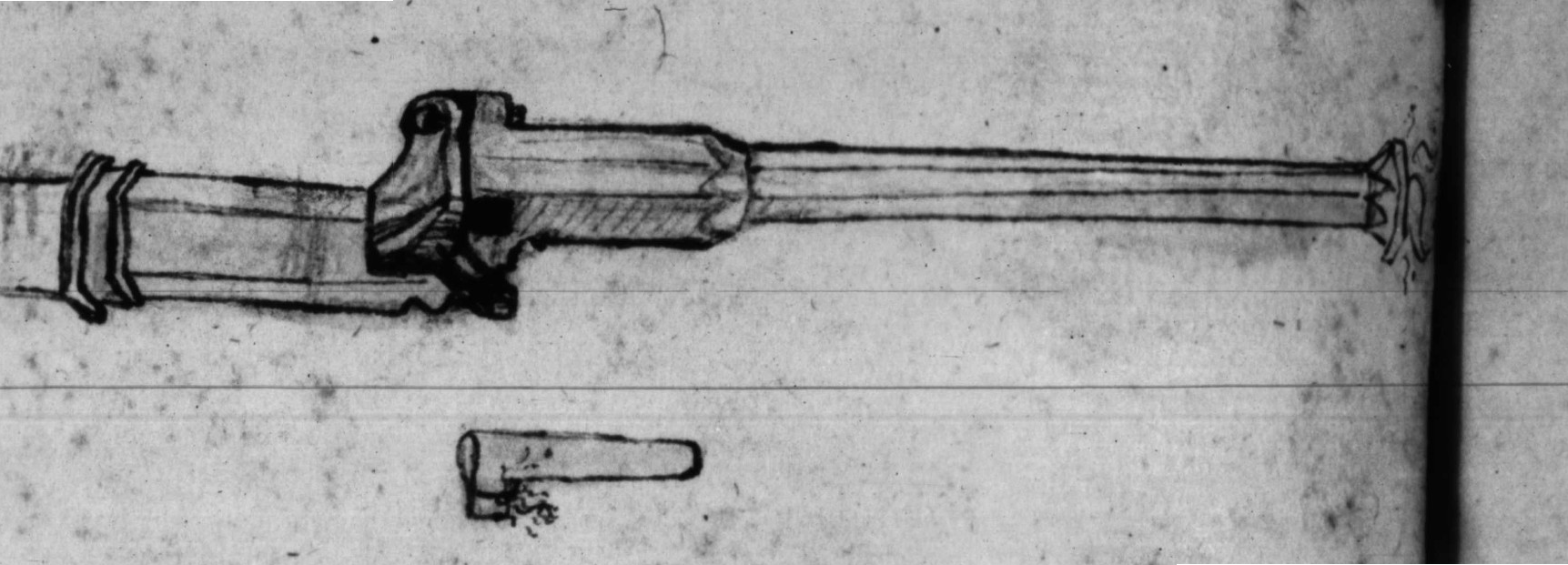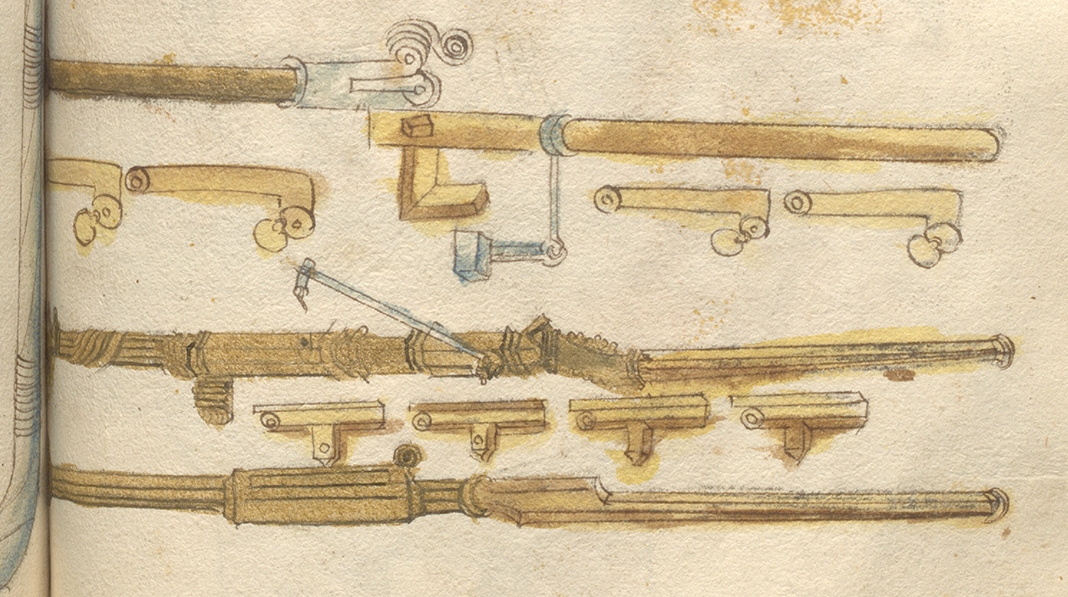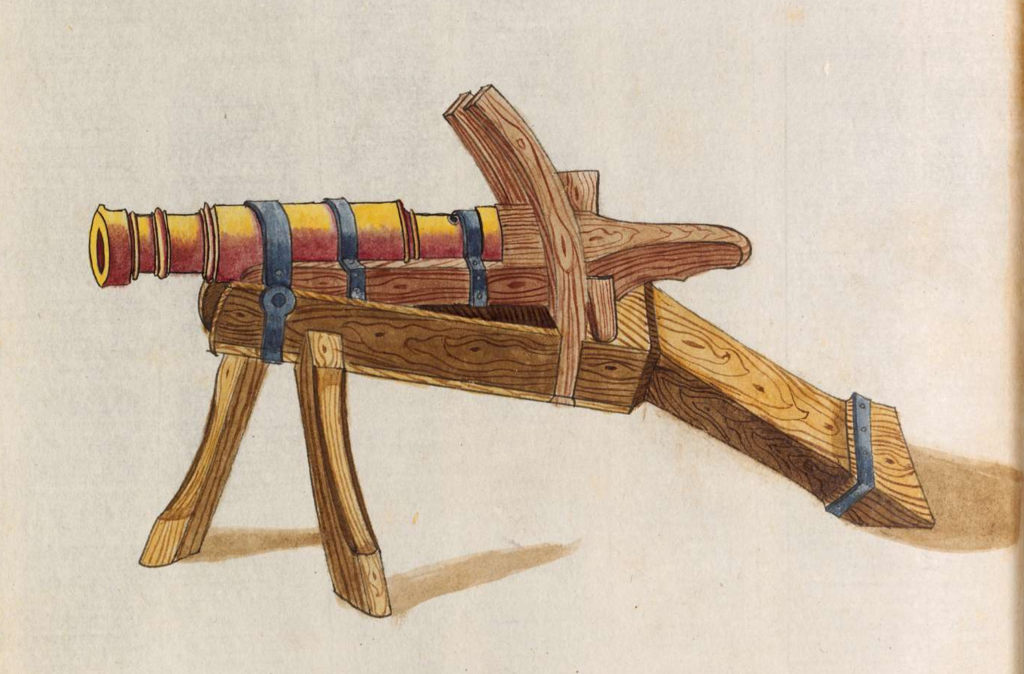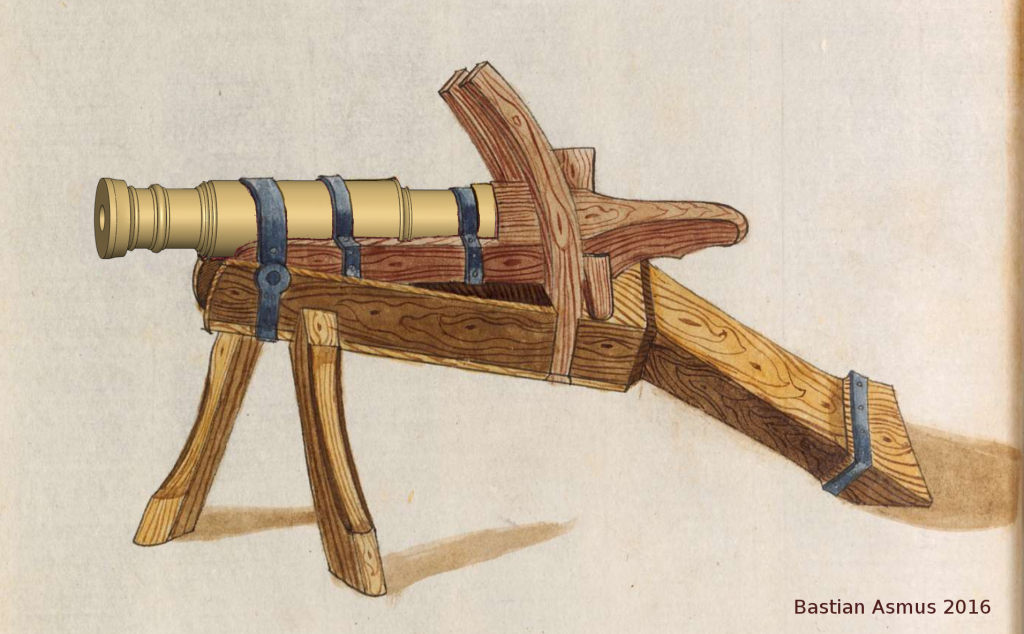VIDEO
In this series of articles I will find out how to make a particular handgonne, and in extension, very early firearms in general; or rather how they could have been manufactured with the contemporary technology. I am not much for guns’n shooting, but I have always been intrigued by the casting process of guns and cannon.
This image of a supposedly 15th century handgonne shows a very early breech loading system, that did not take hold for centuries to come. Technical limitations in the manufacturing process, may well be responsible for this. It could simply not be manufactured as easily as the much more common muzzle loaders. Source: Viking Swords Forum thread 7364.
Vikingswords forum . In this thread another user, Alexander Spiridonov, draws our attention to a treatise, the Zibaldone, by Buonaccorso Ghiberti, grandson of the famous Florentine artist Lorenzo Ghiberti. Here, the handgonne is sketched almost exactly as the piece shown in the forums post.
Image taken from the Buonaccorso Ghiberti, Zibladone, f 83v. It shows the exact same handgonne design as the piece above.
Is the sketch in the Zibaldone a construction sketch, i.e. an original design by Ghiberti, or is it possibly something he saw and jotted down so as not to forget it? We know that the habit of proper citation was not yet established and many authors copied from wherever they could lay there eyes upon.
Other contemporary breech loader designs
The same article by Rietsche Kriegsbuch by Eyb
This very example is an excellent study object to show how much interpretation is necessary to understand it. It also shows that there are various interpretations possible. Let us begin with a proper description of what we see, before we commence with an interpretation:
it is drawn as a composite design
barrel and breech are made from differently coloured sections
it is not clear how the tiller is attached to the handgonne
the tiller appears to be made from material, possibly different to that of the barrel
there is one attachment sliding through the tiller section
there are four objects underneath the handgonne, round in section, bending down rectangularly
the objects possess circular discs, apparently mounted with a rivet to the top end of the bent section
there is a second attachment on the tiller with the same colour as the breech section
the cartridges possess almost the same colour as the tiller
the handgonne at the bottom of the page makes also no distinction colour-wise between tiller and handgonne
the various cartridges display all the same colour
It is unclear how the design of the apparently in steel or iron made receptacle for the cartridge may have looked like. Further it is unclear what the steel or iron attachment at the tiller or socket was used for. Currently it is not clear where one material ends and where another begins, as the colour for bronze and wood is very similar.
Image of a breech loaded handgonne in the Weimarer Ingenieurs- und Wunderbuch form 1520. Clearly a copy of the handgonne design made in the Kriegsbuch by Eyb. Source: Herzogin Amalia Bibliothek Weimarer Ingenieurkunst- und Wunderbuch .
These early breech loaded handgonnes are not recorded as finds anywhere so far. The few surviving handgonnes are all muzzle loaders, with the notable exception of the piece pictured above. If this is a genuine piece, that is. What are the reasons for this seemingly advanced design not taking off in the late 15th and early 16th century? After all this is basically the invention of the cartridge, as we know it. From the arm chair I can think of a few possibilities to be taken into account:
the design was too dangerous, the cartridge issuing from the wrong end of the barrel – hey isn’t that one definition of back-firing?
the design was too difficult to make
the design was not gas tight enough -> poor performance
in the heat of battle this more complicated to use design lent itself to more friendly injuries than inflicting harm to the enemies
the manufacturing of the cartridges proved to labour-some, after all there is no calibration system as yet…
What ever the reason may be, all that these above mentioned ones have in common, is that the design ideas probably evolved faster than the technological development. Currently this is – I am aware of it – pure speculation.
A cast bronze cannon as a previous experiment
A year ago a I begin to recreate the technology to make a 200kg mid to late 15th century cannon. The efforts were documented by the German film team of Peter Prestel and a short synthesis of this project found its way into this documentary (German only) on the German Peasants’ Wars. I have been bronze casting for the last 25 years; there is something about the reconstruction and practical application of ancient technology that evades our modern day workshop experience. It certainly did, where the cannon was concerned. For me the project provided crucial insights. In the end the cannon was not fit for shooting. However this experiment allowed me to test several hypotheses with regards to the moulding and casting technology. Sadly there are no records on the making of such early cannon. There are a lot of late medieval images on the bronze cannon, however only a few on this particular type I reconstructed. It can be found in the Zeugbuch of Maximilian 173 v.
The original painting in Maximilian I. Zeugbuch. Source: urn:nbn:de:bvb:12-bsb00020956-6. Bayerische Staatsbibliothek. Folio 173 v. This represents a cannon of the mid 15th century, its shape reminiscent of the preceding and still contemporary ring rod iron cannon. It is impossible to decide if this represents a gun for lead or stone balls. I decided to reconstruct this as a gun for lead balls with a calibre of 60 mm.
The original painting with the reconstruction edited in place. In this 3D reconstruction I have not yet attached the bead to the cannon, although present in the original. A fact due to the regrettable negligence by the author.
Questions
This project touches on several key interests of mine. What are the process steps involved in making of the handgonne? I am very curious about the performance of these guns, more specifically in the effects the shooting has on the material and mechanical properties of the handgonne. There is so little known about early bronze fire arms. I am willing to put in the effort to contribute towards filling in these gaps. I am all for the challenge to make such a thing, not least of all to solve the problem of casting a piece with a long and narrow core.
But, to the more pressing matters, I want to know:
How well does this handgonne perform?
How well can cast bronze withstand the strain of black powder usage?
How safe is it to use such a firearm?How long can it be used?
How was it made exactly – we know they were cast, but it does stop there?
How was the barrel manufactured exactly?
Cast with core, drilled, reamed, bored?
Which tools were necessary?
Which casting method is the most likely to succeed?
…and numerous small details, that you can only ask if you are versed in application of the artes mechanicae… I really do want to know HOW they were made back in the day and will certainly put in all the faculties that are available to me, to arrive at a hypothesis that I will put to the test.
I am documenting the whole build process in a series of short films which I will make available on my youtube channel . On my FB page I will post smaller updates.
References
{1698736:ZNCSYJJV};{1698736:ZNCSYJJV};{1698736:EB5TFZNQ};{1698736:ZNCSYJJV};{1698736:XGHVKL2J}
apa
default
asc
0
2917
%7B%22status%22%3A%22success%22%2C%22updateneeded%22%3Afalse%2C%22instance%22%3Afalse%2C%22meta%22%3A%7B%22request_last%22%3A1200%2C%22request_next%22%3A50%2C%22used_cache%22%3Atrue%7D%2C%22data%22%3A%5B%7B%22key%22%3A%2226JM8AN2%22%2C%22library%22%3A%7B%22id%22%3A1698736%7D%2C%22meta%22%3A%7B%22creatorSummary%22%3A%22Stephan%20M%5Cu00f6slein%22%2C%22parsedDate%22%3A%222008%22%2C%22numChildren%22%3A1%7D%2C%22bib%22%3A%22%26lt%3Bdiv%20class%3D%26quot%3Bcsl-bib-body%26quot%3B%20style%3D%26quot%3Bline-height%3A%202%3B%20padding-left%3A%202em%3B%20text-indent%3A-2em%3B%26quot%3B%26gt%3B%5Cn%20%20%26lt%3Bdiv%20class%3D%26quot%3Bcsl-entry%26quot%3B%26gt%3BStephan%20M%26%23xF6%3Bslein.%20%282008%29.%20Fr%26%23xFC%3Bhbronzezeitliche%20Depotfunde%20im%20Alpenvorland%20%26%23x2013%3B%20neue%20Befunde%20%28pp.%20109%26%23x2013%3B130%29.%20Presented%20at%20the%20Vortr%26%23xE4%3Bge%20des%2026.%20NIederbayerischen%20Arch%26%23xE4%3Bologentages%2C%20Deggendorf%2C%20Rahden%5C%2FWestfalen.%26lt%3B%5C%2Fdiv%26gt%3B%5Cn%26lt%3B%5C%2Fdiv%26gt%3B%22%2C%22data%22%3A%7B%22itemType%22%3A%22conferencePaper%22%2C%22title%22%3A%22Fr%5Cu00fchbronzezeitliche%20Depotfunde%20im%20Alpenvorland%20%5Cu2013%20neue%20Befunde%22%2C%22creators%22%3A%5B%7B%22creatorType%22%3A%22author%22%2C%22name%22%3A%22Stephan%20M%5Cu00f6slein%22%7D%5D%2C%22abstractNote%22%3A%22%22%2C%22date%22%3A%222008%22%2C%22proceedingsTitle%22%3A%22%22%2C%22conferenceName%22%3A%22Vortr%5Cu00e4ge%20des%2026.%20NIederbayerischen%20Arch%5Cu00e4ologentages%2C%20Deggendorf%22%2C%22language%22%3A%22%22%2C%22DOI%22%3A%22%22%2C%22ISBN%22%3A%22%22%2C%22url%22%3A%22%22%2C%22collections%22%3A%5B%5D%2C%22dateModified%22%3A%222019-05-31T15%3A13%3A30Z%22%7D%7D%2C%7B%22key%22%3A%2246XIMTVI%22%2C%22library%22%3A%7B%22id%22%3A1698736%7D%2C%22meta%22%3A%7B%22creatorSummary%22%3A%22J.J.%20Butler%22%2C%22parsedDate%22%3A%222002%22%2C%22numChildren%22%3A1%7D%2C%22bib%22%3A%22%26lt%3Bdiv%20class%3D%26quot%3Bcsl-bib-body%26quot%3B%20style%3D%26quot%3Bline-height%3A%202%3B%20padding-left%3A%202em%3B%20text-indent%3A-2em%3B%26quot%3B%26gt%3B%5Cn%20%20%26lt%3Bdiv%20class%3D%26quot%3Bcsl-entry%26quot%3B%26gt%3BJ.J.%20Butler.%20%282002%29.%20Ingots%20and%20Insights%3A%20Reflections%20on%20Rings%20and%20Ribs.%20In%20%26lt%3Bi%26gt%3BDie%20Anf%26%23xE4%3Bnge%20der%20Metallurgie%20in%20der%20alten%20Welt%20%3D%3A%20The%20beginnings%20of%20metallurgy%20in%20the%20old%20world%26lt%3B%5C%2Fi%26gt%3B%20%28pp.%20229%26%23x2013%3B243%29.%20Rahden%2C%20Westf%3A%20Verlag%20Marie%20Leidorf.%26lt%3B%5C%2Fdiv%26gt%3B%5Cn%26lt%3B%5C%2Fdiv%26gt%3B%22%2C%22data%22%3A%7B%22itemType%22%3A%22bookSection%22%2C%22title%22%3A%22Ingots%20and%20Insights%3A%20Reflections%20on%20Rings%20and%20Ribs%22%2C%22creators%22%3A%5B%7B%22creatorType%22%3A%22author%22%2C%22name%22%3A%22J.J.%20Butler%22%7D%5D%2C%22abstractNote%22%3A%22%22%2C%22bookTitle%22%3A%22Die%20Anf%5Cu00e4nge%20der%20Metallurgie%20in%20der%20alten%20Welt%20%3D%3A%20The%20beginnings%20of%20metallurgy%20in%20the%20old%20world%22%2C%22date%22%3A%222002%22%2C%22language%22%3A%22ger%20eng%20fre%22%2C%22ISBN%22%3A%22978-3-89646-871-0%22%2C%22url%22%3A%22%22%2C%22collections%22%3A%5B%5D%2C%22dateModified%22%3A%222019-05-31T15%3A09%3A14Z%22%7D%7D%2C%7B%22key%22%3A%22AWUKGXXR%22%2C%22library%22%3A%7B%22id%22%3A1698736%7D%2C%22meta%22%3A%7B%22numChildren%22%3A0%7D%2C%22bib%22%3A%22%26lt%3Bdiv%20class%3D%26quot%3Bcsl-bib-body%26quot%3B%20style%3D%26quot%3Bline-height%3A%202%3B%20padding-left%3A%202em%3B%20text-indent%3A-2em%3B%26quot%3B%26gt%3B%5Cn%20%20%26lt%3Bdiv%20class%3D%26quot%3Bcsl-entry%26quot%3B%26gt%3BIngots%20and%20Insights%3A%20Reflections%20on%20RIngs%20and%20Ribs.%20%28n.d.%29%20%28pp.%20229%26%23x2013%3B243%29.%26lt%3B%5C%2Fdiv%26gt%3B%5Cn%26lt%3B%5C%2Fdiv%26gt%3B%22%2C%22data%22%3A%7B%22itemType%22%3A%22conferencePaper%22%2C%22title%22%3A%22Ingots%20and%20Insights%3A%20Reflections%20on%20RIngs%20and%20Ribs%22%2C%22creators%22%3A%5B%5D%2C%22abstractNote%22%3A%22%22%2C%22date%22%3A%22%22%2C%22proceedingsTitle%22%3A%22%22%2C%22conferenceName%22%3A%22%22%2C%22language%22%3A%22%22%2C%22DOI%22%3A%22%22%2C%22ISBN%22%3A%22%22%2C%22url%22%3A%22%22%2C%22collections%22%3A%5B%5D%2C%22dateModified%22%3A%222019-05-31T15%3A06%3A07Z%22%7D%7D%2C%7B%22key%22%3A%225H87R8UU%22%2C%22library%22%3A%7B%22id%22%3A1698736%7D%2C%22meta%22%3A%7B%22creatorSummary%22%3A%22Dines%22%2C%22parsedDate%22%3A%222010%22%2C%22numChildren%22%3A1%7D%2C%22bib%22%3A%22%26lt%3Bdiv%20class%3D%26quot%3Bcsl-bib-body%26quot%3B%20style%3D%26quot%3Bline-height%3A%202%3B%20padding-left%3A%202em%3B%20text-indent%3A-2em%3B%26quot%3B%26gt%3B%5Cn%20%20%26lt%3Bdiv%20class%3D%26quot%3Bcsl-entry%26quot%3B%26gt%3BDines%2C%20I.%20%282010%29.%20The%20Theophilus%20Manuscript%20Tradition%20Reconsidered%20in%20the%20Light%20of%20New%20Manuscript%20Discoveries.%20In%20M.%20Maui%26%23xE8%3Bge%20%26amp%3B%20H.%20Westerman-Angerhausen%20%28Eds.%29%2C%20%26lt%3Bi%26gt%3BZwischen%20Kunsthandwerk%20und%20Kunst%3A%20Die%20Schedula%20diversarum%20artium%26lt%3B%5C%2Fi%26gt%3B%20%28pp.%203%26%23x2013%3B14%29.%20Berlin%5C%2FBoston%3A%20de%20Gruyter.%26lt%3B%5C%2Fdiv%26gt%3B%5Cn%26lt%3B%5C%2Fdiv%26gt%3B%22%2C%22data%22%3A%7B%22itemType%22%3A%22bookSection%22%2C%22title%22%3A%22The%20Theophilus%20Manuscript%20Tradition%20Reconsidered%20in%20the%20Light%20of%20New%20Manuscript%20Discoveries%22%2C%22creators%22%3A%5B%7B%22creatorType%22%3A%22author%22%2C%22firstName%22%3A%22Ilya%22%2C%22lastName%22%3A%22Dines%22%7D%2C%7B%22creatorType%22%3A%22editor%22%2C%22firstName%22%3A%22Maxime%22%2C%22lastName%22%3A%22Maui%5Cu00e8ge%22%7D%2C%7B%22creatorType%22%3A%22editor%22%2C%22firstName%22%3A%22Hiltrud%22%2C%22lastName%22%3A%22Westerman-Angerhausen%22%7D%5D%2C%22abstractNote%22%3A%22%22%2C%22bookTitle%22%3A%22Zwischen%20Kunsthandwerk%20und%20Kunst%3A%20Die%20Schedula%20diversarum%20artium%22%2C%22date%22%3A%222010%22%2C%22language%22%3A%22%22%2C%22ISBN%22%3A%22%22%2C%22url%22%3A%22%22%2C%22collections%22%3A%5B%5D%2C%22dateModified%22%3A%222019-05-08T07%3A39%3A33Z%22%7D%7D%2C%7B%22key%22%3A%224ICDYHGU%22%2C%22library%22%3A%7B%22id%22%3A1698736%7D%2C%22meta%22%3A%7B%22creatorSummary%22%3A%22Rossi%22%2C%22parsedDate%22%3A%221890%22%2C%22numChildren%22%3A1%7D%2C%22bib%22%3A%22%26lt%3Bdiv%20class%3D%26quot%3Bcsl-bib-body%26quot%3B%20style%3D%26quot%3Bline-height%3A%202%3B%20padding-left%3A%202em%3B%20text-indent%3A-2em%3B%26quot%3B%26gt%3B%5Cn%20%20%26lt%3Bdiv%20class%3D%26quot%3Bcsl-entry%26quot%3B%26gt%3BRossi%2C%20J.-B.%20de.%20%281890%29.%20Cloche%2C%20avec%20inscription%20d%26%23xE9%3Bdicatoire%2C%20du%20VIIIe%20ou%20IXe%20si%26%23xE8%3Bcle%2C%20trouv%26%23xE9%3Be%20%26%23xE0%3B%20Canino.%20%26lt%3Bi%26gt%3BRevue%20de%20l%26%23x2019%3Bart%20Chr%26%23xE9%3Btien%26lt%3B%5C%2Fi%26gt%3B%2C%20%2833%29%2C%201%26%23x2013%3B5.%20Retrieved%20from%20%26lt%3Ba%20class%3D%26%23039%3Bzp-ItemURL%26%23039%3B%20href%3D%26%23039%3Bhttps%3A%5C%2F%5C%2Farchive.org%5C%2Fdetails%5C%2Frevuedelartchr1890lill%26%23039%3B%26gt%3Bhttps%3A%5C%2F%5C%2Farchive.org%5C%2Fdetails%5C%2Frevuedelartchr1890lill%26lt%3B%5C%2Fa%26gt%3B%26lt%3B%5C%2Fdiv%26gt%3B%5Cn%26lt%3B%5C%2Fdiv%26gt%3B%22%2C%22data%22%3A%7B%22itemType%22%3A%22journalArticle%22%2C%22title%22%3A%22Cloche%2C%20avec%20inscription%20d%5Cu00e9dicatoire%2C%20du%20VIIIe%20ou%20IXe%20si%5Cu00e8cle%2C%20trouv%5Cu00e9e%20%5Cu00e0%20Canino%22%2C%22creators%22%3A%5B%7B%22creatorType%22%3A%22author%22%2C%22firstName%22%3A%22J.-Baptista%20de%22%2C%22lastName%22%3A%22Rossi%22%7D%5D%2C%22abstractNote%22%3A%22%22%2C%22date%22%3A%221890%22%2C%22language%22%3A%22%22%2C%22DOI%22%3A%22%22%2C%22ISSN%22%3A%22%22%2C%22url%22%3A%22https%3A%5C%2F%5C%2Farchive.org%5C%2Fdetails%5C%2Frevuedelartchr1890lill%22%2C%22collections%22%3A%5B%5D%2C%22dateModified%22%3A%222019-05-08T07%3A37%3A55Z%22%7D%7D%2C%7B%22key%22%3A%22G52836AQ%22%2C%22library%22%3A%7B%22id%22%3A1698736%7D%2C%22meta%22%3A%7B%22creatorSummary%22%3A%22Drescher%22%2C%22parsedDate%22%3A%221961%22%2C%22numChildren%22%3A1%7D%2C%22bib%22%3A%22%26lt%3Bdiv%20class%3D%26quot%3Bcsl-bib-body%26quot%3B%20style%3D%26quot%3Bline-height%3A%202%3B%20padding-left%3A%202em%3B%20text-indent%3A-2em%3B%26quot%3B%26gt%3B%5Cn%20%20%26lt%3Bdiv%20class%3D%26quot%3Bcsl-entry%26quot%3B%26gt%3BDrescher%2C%20H.%20%281961%29.%20Zwei%20mittelalterliche%20Gie%26%23xDF%3Bereien%20auf%20dem%20Gel%26%23xE4%3Bnde%20des%20ehemaligen%20Hamburger%20Doms.%20%26lt%3Bi%26gt%3BHammaburg%26lt%3B%5C%2Fi%26gt%3B%2C%20%26lt%3Bi%26gt%3BA.%20F.%208%26lt%3B%5C%2Fi%26gt%3B%2C%20107%26%23x2013%3B132.%26lt%3B%5C%2Fdiv%26gt%3B%5Cn%26lt%3B%5C%2Fdiv%26gt%3B%22%2C%22data%22%3A%7B%22itemType%22%3A%22journalArticle%22%2C%22title%22%3A%22Zwei%20mittelalterliche%20Gie%5Cu00dfereien%20auf%20dem%20Gel%5Cu00e4nde%20des%20ehemaligen%20Hamburger%20Doms%22%2C%22creators%22%3A%5B%7B%22creatorType%22%3A%22author%22%2C%22firstName%22%3A%22Hans%22%2C%22lastName%22%3A%22Drescher%22%7D%5D%2C%22abstractNote%22%3A%22%22%2C%22date%22%3A%221961%22%2C%22language%22%3A%22%22%2C%22DOI%22%3A%22%22%2C%22ISSN%22%3A%22%22%2C%22url%22%3A%22%22%2C%22collections%22%3A%5B%5D%2C%22dateModified%22%3A%222019-05-08T07%3A37%3A02Z%22%7D%7D%2C%7B%22key%22%3A%222DF9XDGI%22%2C%22library%22%3A%7B%22id%22%3A1698736%7D%2C%22meta%22%3A%7B%22creatorSummary%22%3A%22Drescher%22%2C%22parsedDate%22%3A%221968%22%2C%22numChildren%22%3A0%7D%2C%22bib%22%3A%22%26lt%3Bdiv%20class%3D%26quot%3Bcsl-bib-body%26quot%3B%20style%3D%26quot%3Bline-height%3A%202%3B%20padding-left%3A%202em%3B%20text-indent%3A-2em%3B%26quot%3B%26gt%3B%5Cn%20%20%26lt%3Bdiv%20class%3D%26quot%3Bcsl-entry%26quot%3B%26gt%3BDrescher%2C%20H.%20%281968%29.%20Mittelalterliche%20Bronzegrapen%20aus%20L%26%23xFC%3Bbeck.%20%26lt%3Bi%26gt%3BDer%20Wagen.%20Ein%20L%26%23xFC%3Bbeckisches%20Jahrbuch%26lt%3B%5C%2Fi%26gt%3B%2C%20164%26%23x2013%3B171.%26lt%3B%5C%2Fdiv%26gt%3B%5Cn%26lt%3B%5C%2Fdiv%26gt%3B%22%2C%22data%22%3A%7B%22itemType%22%3A%22journalArticle%22%2C%22title%22%3A%22Mittelalterliche%20Bronzegrapen%20aus%20L%5Cu00fcbeck%22%2C%22creators%22%3A%5B%7B%22creatorType%22%3A%22author%22%2C%22firstName%22%3A%22Hans%22%2C%22lastName%22%3A%22Drescher%22%7D%5D%2C%22abstractNote%22%3A%22%22%2C%22date%22%3A%221968%22%2C%22language%22%3A%22%22%2C%22DOI%22%3A%22%22%2C%22ISSN%22%3A%22%22%2C%22url%22%3A%22%22%2C%22collections%22%3A%5B%22RI8HAJ3J%22%5D%2C%22dateModified%22%3A%222019-05-08T07%3A36%3A55Z%22%7D%7D%2C%7B%22key%22%3A%228IN9A2H8%22%2C%22library%22%3A%7B%22id%22%3A1698736%7D%2C%22meta%22%3A%7B%22creatorSummary%22%3A%22Drescher%22%2C%22parsedDate%22%3A%221982%22%2C%22numChildren%22%3A0%7D%2C%22bib%22%3A%22%26lt%3Bdiv%20class%3D%26quot%3Bcsl-bib-body%26quot%3B%20style%3D%26quot%3Bline-height%3A%202%3B%20padding-left%3A%202em%3B%20text-indent%3A-2em%3B%26quot%3B%26gt%3B%5Cn%20%20%26lt%3Bdiv%20class%3D%26quot%3Bcsl-entry%26quot%3B%26gt%3BDrescher%2C%20H.%20%281982%29.%20Zu%20den%20bronzenen%20Grapen%20des%2012.-16.%20Jahrhunderts%20aus%20Nordwestdeuschland.%20In%20R.%20Pohl-Weber%20%28Ed.%29%2C%20%26lt%3Bi%26gt%3BAus%20dem%20Alltag%20der%20Mittelalterlichen%20Stadt.%20Handbuch%20zur%20Sonderausstellung%26lt%3B%5C%2Fi%26gt%3B%20%28Vol.%2040%2C%20pp.%20157%26%23x2013%3B174%29.%20Bremen.%26lt%3B%5C%2Fdiv%26gt%3B%5Cn%26lt%3B%5C%2Fdiv%26gt%3B%22%2C%22data%22%3A%7B%22itemType%22%3A%22bookSection%22%2C%22title%22%3A%22Zu%20den%20bronzenen%20Grapen%20des%2012.-16.%20Jahrhunderts%20aus%20Nordwestdeuschland%22%2C%22creators%22%3A%5B%7B%22creatorType%22%3A%22author%22%2C%22firstName%22%3A%22Hans%22%2C%22lastName%22%3A%22Drescher%22%7D%2C%7B%22creatorType%22%3A%22editor%22%2C%22firstName%22%3A%22R.%22%2C%22lastName%22%3A%22Pohl-Weber%22%7D%5D%2C%22abstractNote%22%3A%22%22%2C%22bookTitle%22%3A%22Aus%20dem%20Alltag%20der%20Mittelalterlichen%20Stadt.%20Handbuch%20zur%20Sonderausstellung%22%2C%22date%22%3A%221982%22%2C%22language%22%3A%22%22%2C%22ISBN%22%3A%22%22%2C%22url%22%3A%22%22%2C%22collections%22%3A%5B%22RI8HAJ3J%22%5D%2C%22dateModified%22%3A%222019-05-08T07%3A36%3A43Z%22%7D%7D%2C%7B%22key%22%3A%22FWBHWHWG%22%2C%22library%22%3A%7B%22id%22%3A1698736%7D%2C%22meta%22%3A%7B%22creatorSummary%22%3A%22Drescher%22%2C%22parsedDate%22%3A%221986%22%2C%22numChildren%22%3A0%7D%2C%22bib%22%3A%22%26lt%3Bdiv%20class%3D%26quot%3Bcsl-bib-body%26quot%3B%20style%3D%26quot%3Bline-height%3A%202%3B%20padding-left%3A%202em%3B%20text-indent%3A-2em%3B%26quot%3B%26gt%3B%5Cn%20%20%26lt%3Bdiv%20class%3D%26quot%3Bcsl-entry%26quot%3B%26gt%3BDrescher%2C%20H.%20%281986%29.%20Zum%20Guss%20von%20Bronze%2C%20Messing%20und%20Zinn%20%26%23x201C%3Bum%201200.%26%23x201D%3B%20%26lt%3Bi%26gt%3BZeitschrift%20F%26%23xFC%3Br%20Arch%26%23xE4%3Bologie%20Des%20Mittelalters%26lt%3B%5C%2Fi%26gt%3B%2C%20%26lt%3Bi%26gt%3BBeiheft%204%26lt%3B%5C%2Fi%26gt%3B%2C%20389%26%23x2013%3B405.%26lt%3B%5C%2Fdiv%26gt%3B%5Cn%26lt%3B%5C%2Fdiv%26gt%3B%22%2C%22data%22%3A%7B%22itemType%22%3A%22journalArticle%22%2C%22title%22%3A%22Zum%20Guss%20von%20Bronze%2C%20Messing%20und%20Zinn%20%5C%22um%201200%5C%22%22%2C%22creators%22%3A%5B%7B%22creatorType%22%3A%22author%22%2C%22firstName%22%3A%22Hans%22%2C%22lastName%22%3A%22Drescher%22%7D%5D%2C%22abstractNote%22%3A%22%22%2C%22date%22%3A%221986%22%2C%22language%22%3A%22%22%2C%22DOI%22%3A%22%22%2C%22ISSN%22%3A%22%22%2C%22url%22%3A%22%22%2C%22collections%22%3A%5B%5D%2C%22dateModified%22%3A%222019-05-08T07%3A36%3A34Z%22%7D%7D%2C%7B%22key%22%3A%22P2DXZ99G%22%2C%22library%22%3A%7B%22id%22%3A1698736%7D%2C%22meta%22%3A%7B%22creatorSummary%22%3A%22Drescher%22%2C%22parsedDate%22%3A%221987%22%2C%22numChildren%22%3A0%7D%2C%22bib%22%3A%22%26lt%3Bdiv%20class%3D%26quot%3Bcsl-bib-body%26quot%3B%20style%3D%26quot%3Bline-height%3A%202%3B%20padding-left%3A%202em%3B%20text-indent%3A-2em%3B%26quot%3B%26gt%3B%5Cn%20%20%26lt%3Bdiv%20class%3D%26quot%3Bcsl-entry%26quot%3B%26gt%3BDrescher%2C%20H.%20%281987%29.%20Erg%26%23xE4%3Bnzende%20Bemerkungen%20zum%20Giessereifund%20von%20Bonn-Schwarzrheindorf.%20In%20W.%20Janssen%20%28Ed.%29%2C%20%26lt%3Bi%26gt%3BEine%20mittelalterliche%20Metallgie%26%23xDF%3Berei%20in%20Bonn-Schwarzrheindorf%26lt%3B%5C%2Fi%26gt%3B%20%28Vol.%2027%2C%20pp.%20201%26%23x2013%3B227%29.%26lt%3B%5C%2Fdiv%26gt%3B%5Cn%26lt%3B%5C%2Fdiv%26gt%3B%22%2C%22data%22%3A%7B%22itemType%22%3A%22conferencePaper%22%2C%22title%22%3A%22Erg%5Cu00e4nzende%20Bemerkungen%20zum%20Giessereifund%20von%20Bonn-Schwarzrheindorf%22%2C%22creators%22%3A%5B%7B%22creatorType%22%3A%22author%22%2C%22firstName%22%3A%22Hans%22%2C%22lastName%22%3A%22Drescher%22%7D%2C%7B%22creatorType%22%3A%22editor%22%2C%22firstName%22%3A%22W%22%2C%22lastName%22%3A%22Janssen%22%7D%5D%2C%22abstractNote%22%3A%22%22%2C%22date%22%3A%221987%22%2C%22proceedingsTitle%22%3A%22Eine%20mittelalterliche%20Metallgie%5Cu00dferei%20in%20Bonn-Schwarzrheindorf%22%2C%22conferenceName%22%3A%22%22%2C%22language%22%3A%22%22%2C%22DOI%22%3A%22%22%2C%22ISBN%22%3A%22%22%2C%22url%22%3A%22%22%2C%22collections%22%3A%5B%22RI8HAJ3J%22%5D%2C%22dateModified%22%3A%222019-05-08T07%3A36%3A29Z%22%7D%7D%2C%7B%22key%22%3A%22CPX92XCU%22%2C%22library%22%3A%7B%22id%22%3A1698736%7D%2C%22meta%22%3A%7B%22creatorSummary%22%3A%22Drescher%22%2C%22parsedDate%22%3A%221992%22%2C%22numChildren%22%3A0%7D%2C%22bib%22%3A%22%26lt%3Bdiv%20class%3D%26quot%3Bcsl-bib-body%26quot%3B%20style%3D%26quot%3Bline-height%3A%202%3B%20padding-left%3A%202em%3B%20text-indent%3A-2em%3B%26quot%3B%26gt%3B%5Cn%20%20%26lt%3Bdiv%20class%3D%26quot%3Bcsl-entry%26quot%3B%26gt%3BDrescher%2C%20H.%20%281992%29.%20Glocken%20und%20Glockenguss%20im%2011.%20und%2012.%20Jahrhundert.%20In%20G.%20Waurick%20%26amp%3B%20H.%20W.%20B%26%23xF6%3Bhme%20%28Eds.%29%2C%20%26lt%3Bi%26gt%3BDas%20Reich%20der%20Salier%201024%20-%201125%26%23x202F%3B%3A%20Katalog%20zur%20Ausstellung%20des%20Landes%20Rheinland-Pfalz%3B%20%5BAusstellung%20im%20Historischen%20Museum%20der%20Pfalz%2C%20Speyer%2C%20vom%2023.%20M%26%23xE4%3Brz%20bis%2021.%20Juni%201992%5D%26lt%3B%5C%2Fi%26gt%3B%20%28pp.%20405%26%23x2013%3B414%29.%20Sigmaringen%3A%20Thorbecke.%26lt%3B%5C%2Fdiv%26gt%3B%5Cn%26lt%3B%5C%2Fdiv%26gt%3B%22%2C%22data%22%3A%7B%22itemType%22%3A%22bookSection%22%2C%22title%22%3A%22Glocken%20und%20Glockenguss%20im%2011.%20und%2012.%20Jahrhundert%22%2C%22creators%22%3A%5B%7B%22creatorType%22%3A%22editor%22%2C%22firstName%22%3A%22G%5Cu00f6tz%22%2C%22lastName%22%3A%22Waurick%22%7D%2C%7B%22creatorType%22%3A%22editor%22%2C%22firstName%22%3A%22Horst%20Wolfgang%22%2C%22lastName%22%3A%22B%5Cu00f6hme%22%7D%2C%7B%22creatorType%22%3A%22author%22%2C%22firstName%22%3A%22Hans%22%2C%22lastName%22%3A%22Drescher%22%7D%5D%2C%22abstractNote%22%3A%22%22%2C%22bookTitle%22%3A%22Das%20Reich%20der%20Salier%201024%20-%201125%20%3A%20Katalog%20zur%20Ausstellung%20des%20Landes%20Rheinland-Pfalz%3B%20%5BAusstellung%20im%20Historischen%20Museum%20der%20Pfalz%2C%20Speyer%2C%20vom%2023.%20M%5Cu00e4rz%20bis%2021.%20Juni%201992%5D%22%2C%22date%22%3A%221992%22%2C%22language%22%3A%22%22%2C%22ISBN%22%3A%223-7995-4140-3%22%2C%22url%22%3A%22%22%2C%22collections%22%3A%5B%5D%2C%22dateModified%22%3A%222019-05-08T07%3A36%3A21Z%22%7D%7D%2C%7B%22key%22%3A%226WNC9C3B%22%2C%22library%22%3A%7B%22id%22%3A1698736%7D%2C%22meta%22%3A%7B%22creatorSummary%22%3A%22Drescher%22%2C%22parsedDate%22%3A%221993%22%2C%22numChildren%22%3A0%7D%2C%22bib%22%3A%22%26lt%3Bdiv%20class%3D%26quot%3Bcsl-bib-body%26quot%3B%20style%3D%26quot%3Bline-height%3A%202%3B%20padding-left%3A%202em%3B%20text-indent%3A-2em%3B%26quot%3B%26gt%3B%5Cn%20%20%26lt%3Bdiv%20class%3D%26quot%3Bcsl-entry%26quot%3B%26gt%3BDrescher%2C%20H.%20%281993%29.%20Ein%20Kommentar%20zu%3A%20Gerhard%20Laub%2C%20Zum%20Nachweis%20von%20Rammelsberger%20Kupfer%20in%20Kunstgegenst%26%23xE4%3Bnden%20aus%20Goslar%20und%20in%20anderen%20Metallarbeiten%20des%20Mittelalters.%20In%20%26lt%3Bi%26gt%3BGoslar%20Bergstadt%20-%20Kaiserstadt%20in%20Geschichte%20und%20Kunst%26lt%3B%5C%2Fi%26gt%3B%20%28pp.%20313%26%23x2013%3B316%29.%26lt%3B%5C%2Fdiv%26gt%3B%5Cn%26lt%3B%5C%2Fdiv%26gt%3B%22%2C%22data%22%3A%7B%22itemType%22%3A%22bookSection%22%2C%22title%22%3A%22Ein%20Kommentar%20zu%3A%20Gerhard%20Laub%2C%20Zum%20Nachweis%20von%20Rammelsberger%20Kupfer%20in%20Kunstgegenst%5Cu00e4nden%20aus%20Goslar%20und%20in%20anderen%20Metallarbeiten%20des%20Mittelalters%22%2C%22creators%22%3A%5B%7B%22creatorType%22%3A%22author%22%2C%22firstName%22%3A%22Hans%22%2C%22lastName%22%3A%22Drescher%22%7D%5D%2C%22abstractNote%22%3A%22%22%2C%22bookTitle%22%3A%22Goslar%20Bergstadt%20-%20Kaiserstadt%20in%20Geschichte%20und%20Kunst%22%2C%22date%22%3A%221993%22%2C%22language%22%3A%22%22%2C%22ISBN%22%3A%22%22%2C%22url%22%3A%22%22%2C%22collections%22%3A%5B%22RI8HAJ3J%22%5D%2C%22dateModified%22%3A%222019-05-08T07%3A36%3A16Z%22%7D%7D%2C%7B%22key%22%3A%22RKIKABBU%22%2C%22library%22%3A%7B%22id%22%3A1698736%7D%2C%22meta%22%3A%7B%22creatorSummary%22%3A%22Drescher%22%2C%22parsedDate%22%3A%221993%22%2C%22numChildren%22%3A0%7D%2C%22bib%22%3A%22%26lt%3Bdiv%20class%3D%26quot%3Bcsl-bib-body%26quot%3B%20style%3D%26quot%3Bline-height%3A%202%3B%20padding-left%3A%202em%3B%20text-indent%3A-2em%3B%26quot%3B%26gt%3B%5Cn%20%20%26lt%3Bdiv%20class%3D%26quot%3Bcsl-entry%26quot%3B%26gt%3BDrescher%2C%20H.%20%281993%29.%20Zur%20Herstellungstechnik%20mittelalterlicher%20Bronzen%20aus%20Goslar.%20Der%20Marktbrunnen%2C%20der%20neu%20gefundene%20Bronze%20Vogel%2C%20der%20Greif%20vom%20Kaiserhaus%20und%20der%20Kaiserstuhl.%20In%20%26lt%3Bi%26gt%3BGoslar%20Bergstadt%20-%20Kaiserstadt%20in%20Geschichte%20und%20Kunst%26lt%3B%5C%2Fi%26gt%3B%20%28pp.%20251%26%23x2013%3B301%29.%20G%26%23xF6%3Bttingen.%26lt%3B%5C%2Fdiv%26gt%3B%5Cn%26lt%3B%5C%2Fdiv%26gt%3B%22%2C%22data%22%3A%7B%22itemType%22%3A%22bookSection%22%2C%22title%22%3A%22Zur%20Herstellungstechnik%20mittelalterlicher%20Bronzen%20aus%20Goslar.%20Der%20Marktbrunnen%2C%20der%20neu%20gefundene%20Bronze%20Vogel%2C%20der%20Greif%20vom%20Kaiserhaus%20und%20der%20Kaiserstuhl%22%2C%22creators%22%3A%5B%7B%22creatorType%22%3A%22author%22%2C%22firstName%22%3A%22Hans%22%2C%22lastName%22%3A%22Drescher%22%7D%5D%2C%22abstractNote%22%3A%22%22%2C%22bookTitle%22%3A%22Goslar%20Bergstadt%20-%20Kaiserstadt%20in%20Geschichte%20und%20Kunst%22%2C%22date%22%3A%221993%22%2C%22language%22%3A%22%22%2C%22ISBN%22%3A%22%22%2C%22url%22%3A%22%22%2C%22collections%22%3A%5B%22RI8HAJ3J%22%5D%2C%22dateModified%22%3A%222019-05-08T07%3A36%3A12Z%22%7D%7D%2C%7B%22key%22%3A%22FFUFS9V6%22%2C%22library%22%3A%7B%22id%22%3A1698736%7D%2C%22meta%22%3A%7B%22creatorSummary%22%3A%22Drescher%22%2C%22parsedDate%22%3A%221993%22%2C%22numChildren%22%3A0%7D%2C%22bib%22%3A%22%26lt%3Bdiv%20class%3D%26quot%3Bcsl-bib-body%26quot%3B%20style%3D%26quot%3Bline-height%3A%202%3B%20padding-left%3A%202em%3B%20text-indent%3A-2em%3B%26quot%3B%26gt%3B%5Cn%20%20%26lt%3Bdiv%20class%3D%26quot%3Bcsl-entry%26quot%3B%26gt%3BDrescher%2C%20H.%20%281993%29.%20Zur%20Technik%20berwardinischer%20Silber-%20und%20Bronzeg%26%23xFC%3Bsse.%20In%20%26lt%3Bi%26gt%3BBernward%20von%20Hildesheim%20und%20das%20Zeitalter%20der%20Ottonen%3A%20Katalog%20der%20Ausstellung%2C%20Hildesheim%201993.%20Band%201%26lt%3B%5C%2Fi%26gt%3B%20%28pp.%20337%26%23x2013%3B351%29.%26lt%3B%5C%2Fdiv%26gt%3B%5Cn%26lt%3B%5C%2Fdiv%26gt%3B%22%2C%22data%22%3A%7B%22itemType%22%3A%22bookSection%22%2C%22title%22%3A%22Zur%20Technik%20berwardinischer%20Silber-%20und%20Bronzeg%5Cu00fcsse%22%2C%22creators%22%3A%5B%7B%22creatorType%22%3A%22author%22%2C%22firstName%22%3A%22Hans%22%2C%22lastName%22%3A%22Drescher%22%7D%5D%2C%22abstractNote%22%3A%22%22%2C%22bookTitle%22%3A%22Bernward%20von%20Hildesheim%20und%20das%20Zeitalter%20der%20Ottonen%3A%20Katalog%20der%20Ausstellung%2C%20Hildesheim%201993.%20Band%201%22%2C%22date%22%3A%221993%22%2C%22language%22%3A%22%22%2C%22ISBN%22%3A%22%22%2C%22url%22%3A%22%22%2C%22collections%22%3A%5B%22RI8HAJ3J%22%5D%2C%22dateModified%22%3A%222019-05-08T07%3A36%3A07Z%22%7D%7D%2C%7B%22key%22%3A%22CKJS5RNK%22%2C%22library%22%3A%7B%22id%22%3A1698736%7D%2C%22meta%22%3A%7B%22creatorSummary%22%3A%22Drescher%22%2C%22parsedDate%22%3A%221995%22%2C%22numChildren%22%3A1%7D%2C%22bib%22%3A%22%26lt%3Bdiv%20class%3D%26quot%3Bcsl-bib-body%26quot%3B%20style%3D%26quot%3Bline-height%3A%202%3B%20padding-left%3A%202em%3B%20text-indent%3A-2em%3B%26quot%3B%26gt%3B%5Cn%20%20%26lt%3Bdiv%20class%3D%26quot%3Bcsl-entry%26quot%3B%26gt%3BDrescher%2C%20H.%20%281995%29.%20Gie%26%23xDF%3Bformen%20fr%26%23xFC%3Bher%20Glocken%20aus%20Mainz.%20%26lt%3Bi%26gt%3BMainzer%20Zeitschrift%26lt%3B%5C%2Fi%26gt%3B%2C%20%26lt%3Bi%26gt%3B90%5C%2F91%26lt%3B%5C%2Fi%26gt%3B%2C%20183%26%23x2013%3B225.%26lt%3B%5C%2Fdiv%26gt%3B%5Cn%26lt%3B%5C%2Fdiv%26gt%3B%22%2C%22data%22%3A%7B%22itemType%22%3A%22journalArticle%22%2C%22title%22%3A%22Gie%5Cu00dfformen%20fr%5Cu00fcher%20Glocken%20aus%20Mainz%22%2C%22creators%22%3A%5B%7B%22creatorType%22%3A%22author%22%2C%22firstName%22%3A%22Hans%22%2C%22lastName%22%3A%22Drescher%22%7D%5D%2C%22abstractNote%22%3A%22%22%2C%22date%22%3A%221995%5C%2F96%22%2C%22language%22%3A%22%22%2C%22DOI%22%3A%22%22%2C%22ISSN%22%3A%22%22%2C%22url%22%3A%22%22%2C%22collections%22%3A%5B%5D%2C%22dateModified%22%3A%222019-05-08T07%3A36%3A02Z%22%7D%7D%2C%7B%22key%22%3A%22JNZVJZ6N%22%2C%22library%22%3A%7B%22id%22%3A1698736%7D%2C%22meta%22%3A%7B%22creatorSummary%22%3A%22Drescher%22%2C%22parsedDate%22%3A%221999%22%2C%22numChildren%22%3A0%7D%2C%22bib%22%3A%22%26lt%3Bdiv%20class%3D%26quot%3Bcsl-bib-body%26quot%3B%20style%3D%26quot%3Bline-height%3A%202%3B%20padding-left%3A%202em%3B%20text-indent%3A-2em%3B%26quot%3B%26gt%3B%5Cn%20%20%26lt%3Bdiv%20class%3D%26quot%3Bcsl-entry%26quot%3B%26gt%3BDrescher%2C%20H.%20%281999%29.%20Die%20Glocken%20der%20karolingerzeitlichen%20Stiftdkirche%20bei%20Vreden%2C%20Kreis%20Ahaus.%20In%20C.%20Stiegemann%20%26amp%3B%20M.%20Wemhoff%20%28Eds.%29%2C%20%26lt%3Bi%26gt%3B799%2C%20Kunst%20und%20Kultur%20der%20Karolingerzeit%3A%20Karl%20der%20Grosse%20und%20Papst%20Leo%20III.%20in%20Paderborn%3A%20Katalog%20der%20Ausstellung%2C%20Paderborn%201999%26lt%3B%5C%2Fi%26gt%3B%20%28pp.%20356%26%23x2013%3B364%29.%20Mainz%3A%20P.%20von%20Zabern.%26lt%3B%5C%2Fdiv%26gt%3B%5Cn%26lt%3B%5C%2Fdiv%26gt%3B%22%2C%22data%22%3A%7B%22itemType%22%3A%22bookSection%22%2C%22title%22%3A%22Die%20Glocken%20der%20karolingerzeitlichen%20Stiftdkirche%20bei%20Vreden%2C%20Kreis%20Ahaus%22%2C%22creators%22%3A%5B%7B%22creatorType%22%3A%22editor%22%2C%22firstName%22%3A%22Christoph%22%2C%22lastName%22%3A%22Stiegemann%22%7D%2C%7B%22creatorType%22%3A%22editor%22%2C%22firstName%22%3A%22Matthias%22%2C%22lastName%22%3A%22Wemhoff%22%7D%2C%7B%22creatorType%22%3A%22author%22%2C%22firstName%22%3A%22Hans%22%2C%22lastName%22%3A%22Drescher%22%7D%5D%2C%22abstractNote%22%3A%22%22%2C%22bookTitle%22%3A%22799%2C%20Kunst%20und%20Kultur%20der%20Karolingerzeit%3A%20Karl%20der%20Grosse%20und%20Papst%20Leo%20III.%20in%20Paderborn%3A%20Katalog%20der%20Ausstellung%2C%20Paderborn%201999%22%2C%22date%22%3A%221999%22%2C%22language%22%3A%22%22%2C%22ISBN%22%3A%22978-3-8053-2456-4%20978-3-8053-2460-1%22%2C%22url%22%3A%22%22%2C%22collections%22%3A%5B%5D%2C%22dateModified%22%3A%222019-05-08T07%3A35%3A56Z%22%7D%7D%2C%7B%22key%22%3A%227ZV3MN3T%22%2C%22library%22%3A%7B%22id%22%3A1698736%7D%2C%22meta%22%3A%7B%22creatorSummary%22%3A%22Janssen%22%2C%22parsedDate%22%3A%221987%22%2C%22numChildren%22%3A0%7D%2C%22bib%22%3A%22%26lt%3Bdiv%20class%3D%26quot%3Bcsl-bib-body%26quot%3B%20style%3D%26quot%3Bline-height%3A%202%3B%20padding-left%3A%202em%3B%20text-indent%3A-2em%3B%26quot%3B%26gt%3B%5Cn%20%20%26lt%3Bdiv%20class%3D%26quot%3Bcsl-entry%26quot%3B%26gt%3BJanssen%2C%20W.%20%281987%29.%20Eine%20mittelalterliche%20Metallgie%26%23xDF%3Berei%20in%20Bonn-%20Schwarzrheindorf.%20Mit%20Beitr%26%23xE4%3Bgen%20von%20Hans%20Drescher%2C%20Christoph%20J.%20Raub%20und%20Josef%20Riederer.%20In%20%26lt%3Bi%26gt%3BBeitr%26%23xE4%3Bge%20zur%20Arch%26%23xE4%3Bologie%20des%20Rheinlandes.%20Rheinische%20Ausgrabungen%26lt%3B%5C%2Fi%26gt%3B%20%28Vol.%2027%2C%20pp.%20135%26%23x2013%3B235%29.%20K%26%23xF6%3Bln.%26lt%3B%5C%2Fdiv%26gt%3B%5Cn%26lt%3B%5C%2Fdiv%26gt%3B%22%2C%22data%22%3A%7B%22itemType%22%3A%22bookSection%22%2C%22title%22%3A%22Eine%20mittelalterliche%20Metallgie%5Cu00dferei%20in%20Bonn-%20Schwarzrheindorf.%20Mit%20Beitr%5Cu00e4gen%20von%20Hans%20Drescher%2C%20Christoph%20J.%20Raub%20und%20Josef%20Riederer.%22%2C%22creators%22%3A%5B%7B%22creatorType%22%3A%22author%22%2C%22firstName%22%3A%22Walter%22%2C%22lastName%22%3A%22Janssen%22%7D%5D%2C%22abstractNote%22%3A%22%22%2C%22bookTitle%22%3A%22Beitr%5Cu00e4ge%20zur%20Arch%5Cu00e4ologie%20des%20Rheinlandes.%20Rheinische%20Ausgrabungen%22%2C%22date%22%3A%221987%22%2C%22language%22%3A%22%22%2C%22ISBN%22%3A%22%22%2C%22url%22%3A%22%22%2C%22collections%22%3A%5B%5D%2C%22dateModified%22%3A%222019-05-08T07%3A35%3A49Z%22%7D%7D%2C%7B%22key%22%3A%22EXBIW7AU%22%2C%22library%22%3A%7B%22id%22%3A1698736%7D%2C%22meta%22%3A%7B%22creatorSummary%22%3A%22Haiduck%22%2C%22parsedDate%22%3A%221997%22%2C%22numChildren%22%3A1%7D%2C%22bib%22%3A%22%26lt%3Bdiv%20class%3D%26quot%3Bcsl-bib-body%26quot%3B%20style%3D%26quot%3Bline-height%3A%202%3B%20padding-left%3A%202em%3B%20text-indent%3A-2em%3B%26quot%3B%26gt%3B%5Cn%20%20%26lt%3Bdiv%20class%3D%26quot%3Bcsl-entry%26quot%3B%26gt%3BHaiduck%2C%20H.%20%281997%29.%20Die%20mittelalterliche%20Gussform%20eines%20Taufkessels%20aus%20der%20Kirche%20von%20Cappel%20%28Kreis%20Cuxhaven%29.%20%26lt%3Bi%26gt%3BZeitschrift%20F%26%23xFC%3Br%20Arch%26%23xE4%3Bologie%20Des%20Mittelalters%26lt%3B%5C%2Fi%26gt%3B%2C%20%26lt%3Bi%26gt%3B25%5C%2F26%26lt%3B%5C%2Fi%26gt%3B%2C%2087%26%23x2013%3B105.%26lt%3B%5C%2Fdiv%26gt%3B%5Cn%26lt%3B%5C%2Fdiv%26gt%3B%22%2C%22data%22%3A%7B%22itemType%22%3A%22journalArticle%22%2C%22title%22%3A%22Die%20mittelalterliche%20Gussform%20eines%20Taufkessels%20aus%20der%20Kirche%20von%20Cappel%20%28Kreis%20Cuxhaven%29%22%2C%22creators%22%3A%5B%7B%22creatorType%22%3A%22author%22%2C%22firstName%22%3A%22H.%22%2C%22lastName%22%3A%22Haiduck%22%7D%5D%2C%22abstractNote%22%3A%22%22%2C%22date%22%3A%221997%5C%2F98%22%2C%22language%22%3A%22%22%2C%22DOI%22%3A%22%22%2C%22ISSN%22%3A%22%22%2C%22url%22%3A%22%22%2C%22collections%22%3A%5B%5D%2C%22dateModified%22%3A%222019-05-08T07%3A35%3A16Z%22%7D%7D%2C%7B%22key%22%3A%22WZJGGXE6%22%2C%22library%22%3A%7B%22id%22%3A1698736%7D%2C%22meta%22%3A%7B%22creatorSummary%22%3A%22Sugaki%20et%20al.%22%2C%22parsedDate%22%3A%221981%22%2C%22numChildren%22%3A0%7D%2C%22bib%22%3A%22%26lt%3Bdiv%20class%3D%26quot%3Bcsl-bib-body%26quot%3B%20style%3D%26quot%3Bline-height%3A%202%3B%20padding-left%3A%202em%3B%20text-indent%3A-2em%3B%26quot%3B%26gt%3B%5Cn%20%20%26lt%3Bdiv%20class%3D%26quot%3Bcsl-entry%26quot%3B%26gt%3BSugaki%2C%20A.%2C%20Shima%2C%20H.%2C%20Kitakaze%2C%20A.%2C%20%26amp%3B%20Mizota%2C%20T.%20%281981%29.%20Hydrothermal%20synthesis%20of%20nukundamite%20and%20its%20crystal%20structure.%20%26lt%3Bi%26gt%3BAmerican%20Mineralogist%26lt%3B%5C%2Fi%26gt%3B%2C%20%26lt%3Bi%26gt%3B66%26lt%3B%5C%2Fi%26gt%3B%2C%20398%26%23x2013%3B402.%26lt%3B%5C%2Fdiv%26gt%3B%5Cn%26lt%3B%5C%2Fdiv%26gt%3B%22%2C%22data%22%3A%7B%22itemType%22%3A%22journalArticle%22%2C%22title%22%3A%22Hydrothermal%20synthesis%20of%20nukundamite%20and%20its%20crystal%20structure%22%2C%22creators%22%3A%5B%7B%22creatorType%22%3A%22author%22%2C%22firstName%22%3A%22A.%22%2C%22lastName%22%3A%22Sugaki%22%7D%2C%7B%22creatorType%22%3A%22author%22%2C%22firstName%22%3A%22H.%22%2C%22lastName%22%3A%22Shima%22%7D%2C%7B%22creatorType%22%3A%22author%22%2C%22firstName%22%3A%22A.%22%2C%22lastName%22%3A%22Kitakaze%22%7D%2C%7B%22creatorType%22%3A%22author%22%2C%22firstName%22%3A%22T.%22%2C%22lastName%22%3A%22Mizota%22%7D%5D%2C%22abstractNote%22%3A%22%22%2C%22date%22%3A%221981%22%2C%22language%22%3A%22%22%2C%22DOI%22%3A%22%22%2C%22ISSN%22%3A%22%22%2C%22url%22%3A%22%22%2C%22collections%22%3A%5B%22RI8HAJ3J%22%5D%2C%22dateModified%22%3A%222019-05-08T07%3A34%3A06Z%22%7D%7D%2C%7B%22key%22%3A%22MIQUCSWR%22%2C%22library%22%3A%7B%22id%22%3A1698736%7D%2C%22meta%22%3A%7B%22creatorSummary%22%3A%22Suhling%22%2C%22parsedDate%22%3A%221997%22%2C%22numChildren%22%3A0%7D%2C%22bib%22%3A%22%26lt%3Bdiv%20class%3D%26quot%3Bcsl-bib-body%26quot%3B%20style%3D%26quot%3Bline-height%3A%202%3B%20padding-left%3A%202em%3B%20text-indent%3A-2em%3B%26quot%3B%26gt%3B%5Cn%20%20%26lt%3Bdiv%20class%3D%26quot%3Bcsl-entry%26quot%3B%26gt%3BSuhling%2C%20L.%20%281997%29.%20Kupfer-%20und%20Silberh%26%23xFC%3Btten%20in%20Buchillustrationen%20der%20fr%26%23xFC%3Bhen%20Neuzeit.%20%26lt%3Bi%26gt%3BBerichte%20Der%20Geologischen%20Bundesanstalt%26lt%3B%5C%2Fi%26gt%3B%2C%20%26lt%3Bi%26gt%3B41%26lt%3B%5C%2Fi%26gt%3B%2C%20219%26%23x2013%3B231.%26lt%3B%5C%2Fdiv%26gt%3B%5Cn%26lt%3B%5C%2Fdiv%26gt%3B%22%2C%22data%22%3A%7B%22itemType%22%3A%22journalArticle%22%2C%22title%22%3A%22Kupfer-%20und%20Silberh%5Cu00fctten%20in%20Buchillustrationen%20der%20fr%5Cu00fchen%20Neuzeit%22%2C%22creators%22%3A%5B%7B%22creatorType%22%3A%22author%22%2C%22firstName%22%3A%22Lothar%22%2C%22lastName%22%3A%22Suhling%22%7D%5D%2C%22abstractNote%22%3A%22%22%2C%22date%22%3A%221997%22%2C%22language%22%3A%22%22%2C%22DOI%22%3A%22%22%2C%22ISSN%22%3A%22%22%2C%22url%22%3A%22%22%2C%22collections%22%3A%5B%22RI8HAJ3J%22%5D%2C%22dateModified%22%3A%222019-05-08T07%3A33%3A49Z%22%7D%7D%2C%7B%22key%22%3A%22DGKI7EUF%22%2C%22library%22%3A%7B%22id%22%3A1698736%7D%2C%22meta%22%3A%7B%22creatorSummary%22%3A%22Telle%20and%20Th%5Cu00f6nni%5Cu00dfen%22%2C%22parsedDate%22%3A%222006%22%2C%22numChildren%22%3A0%7D%2C%22bib%22%3A%22%26lt%3Bdiv%20class%3D%26quot%3Bcsl-bib-body%26quot%3B%20style%3D%26quot%3Bline-height%3A%202%3B%20padding-left%3A%202em%3B%20text-indent%3A-2em%3B%26quot%3B%26gt%3B%5Cn%20%20%26lt%3Bdiv%20class%3D%26quot%3Bcsl-entry%26quot%3B%26gt%3BTelle%2C%20R.%2C%20%26amp%3B%20Th%26%23xF6%3Bnni%26%23xDF%3Ben%2C%20M.%20%282006%29.%20Pr%26%23xE4%3Bhistorische%20feuerfeste%20Werkstoffe%20und%20ihre%20Weiterentwicklung%20in%20keltischer%20und%20r%26%23xF6%3Bmischer%20Zeit.%20%26lt%3Bi%26gt%3BPr%26%23xE4%3Bhistorische%20Feuerfeste%20Werkstoffe%20Und%20Ihre%20Weiterentwicklung%20in%20Keltischer%20Und%20R%26%23xF6%3Bmischer%20Zeit%26lt%3B%5C%2Fi%26gt%3B%2C%20%26lt%3Bi%26gt%3B43%26lt%3B%5C%2Fi%26gt%3B%282%29%2C%2055%26%23x2013%3B87.%26lt%3B%5C%2Fdiv%26gt%3B%5Cn%26lt%3B%5C%2Fdiv%26gt%3B%22%2C%22data%22%3A%7B%22itemType%22%3A%22journalArticle%22%2C%22title%22%3A%22Pr%5Cu00e4historische%20feuerfeste%20Werkstoffe%20und%20ihre%20Weiterentwicklung%20in%20keltischer%20und%20r%5Cu00f6mischer%20Zeit%22%2C%22creators%22%3A%5B%7B%22creatorType%22%3A%22author%22%2C%22firstName%22%3A%22Rainer%22%2C%22lastName%22%3A%22Telle%22%7D%2C%7B%22creatorType%22%3A%22author%22%2C%22firstName%22%3A%22Martina%22%2C%22lastName%22%3A%22Th%5Cu00f6nni%5Cu00dfen%22%7D%5D%2C%22abstractNote%22%3A%22%22%2C%22date%22%3A%222006%22%2C%22language%22%3A%22%22%2C%22DOI%22%3A%22%22%2C%22ISSN%22%3A%22%22%2C%22url%22%3A%22%22%2C%22collections%22%3A%5B%22RI8HAJ3J%22%5D%2C%22dateModified%22%3A%222019-05-08T07%3A33%3A27Z%22%7D%7D%2C%7B%22key%22%3A%22M7EWRSMR%22%2C%22library%22%3A%7B%22id%22%3A1698736%7D%2C%22meta%22%3A%7B%22creatorSummary%22%3A%22Thies%22%2C%22parsedDate%22%3A%221993%22%2C%22numChildren%22%3A0%7D%2C%22bib%22%3A%22%26lt%3Bdiv%20class%3D%26quot%3Bcsl-bib-body%26quot%3B%20style%3D%26quot%3Bline-height%3A%202%3B%20padding-left%3A%202em%3B%20text-indent%3A-2em%3B%26quot%3B%26gt%3B%5Cn%20%20%26lt%3Bdiv%20class%3D%26quot%3Bcsl-entry%26quot%3B%26gt%3BThies%2C%20H.%20%281993%29.%20Goslar%20und%20die%20fr%26%23xFC%3Bhen%20nieders%26%23xE4%3Bchsichen%20Geb%26%23xE4%3Bude.%20In%20%26lt%3Bi%26gt%3BGoslar%20Bergstadt%20-%20Kaiserstadt%20in%20Geschichte%20und%20Kunst%26lt%3B%5C%2Fi%26gt%3B%20%28pp.%2095%26%23x2013%3B113%29.%26lt%3B%5C%2Fdiv%26gt%3B%5Cn%26lt%3B%5C%2Fdiv%26gt%3B%22%2C%22data%22%3A%7B%22itemType%22%3A%22bookSection%22%2C%22title%22%3A%22Goslar%20und%20die%20fr%5Cu00fchen%20nieders%5Cu00e4chsichen%20Geb%5Cu00e4ude%22%2C%22creators%22%3A%5B%7B%22creatorType%22%3A%22author%22%2C%22firstName%22%3A%22Harmen%22%2C%22lastName%22%3A%22Thies%22%7D%5D%2C%22abstractNote%22%3A%22%22%2C%22bookTitle%22%3A%22Goslar%20Bergstadt%20-%20Kaiserstadt%20in%20Geschichte%20und%20Kunst%22%2C%22date%22%3A%221993%22%2C%22language%22%3A%22%22%2C%22ISBN%22%3A%22%22%2C%22url%22%3A%22%22%2C%22collections%22%3A%5B%22RI8HAJ3J%22%5D%2C%22dateModified%22%3A%222019-05-08T07%3A33%3A19Z%22%7D%7D%2C%7B%22key%22%3A%2252VEN5A4%22%2C%22library%22%3A%7B%22id%22%3A1698736%7D%2C%22meta%22%3A%7B%22creatorSummary%22%3A%22Tholl%22%2C%22parsedDate%22%3A%222001%22%2C%22numChildren%22%3A0%7D%2C%22bib%22%3A%22%26lt%3Bdiv%20class%3D%26quot%3Bcsl-bib-body%26quot%3B%20style%3D%26quot%3Bline-height%3A%202%3B%20padding-left%3A%202em%3B%20text-indent%3A-2em%3B%26quot%3B%26gt%3B%5Cn%20%20%26lt%3Bdiv%20class%3D%26quot%3Bcsl-entry%26quot%3B%26gt%3BTholl%2C%20S.%20%282001%29.%20Macht%20und%20Pracht.%20In%20%26lt%3Bi%26gt%3BDer%20Rammelsberg.%20Tausend%20Jahre%20Mensch%20%26%23x2013%3B%20Natur%20%26%23x2013%3B%20Technik.%20Band%202%26lt%3B%5C%2Fi%26gt%3B%20%28pp.%20302%26%23x2013%3B315%29.%26lt%3B%5C%2Fdiv%26gt%3B%5Cn%26lt%3B%5C%2Fdiv%26gt%3B%22%2C%22data%22%3A%7B%22itemType%22%3A%22bookSection%22%2C%22title%22%3A%22Macht%20und%20Pracht%22%2C%22creators%22%3A%5B%7B%22creatorType%22%3A%22author%22%2C%22firstName%22%3A%22Stefan%22%2C%22lastName%22%3A%22Tholl%22%7D%5D%2C%22abstractNote%22%3A%22%22%2C%22bookTitle%22%3A%22Der%20Rammelsberg.%20Tausend%20Jahre%20Mensch%20%5Cu2013%20Natur%20%5Cu2013%20Technik.%20Band%202%22%2C%22date%22%3A%222001%22%2C%22language%22%3A%22%22%2C%22ISBN%22%3A%22%22%2C%22url%22%3A%22%22%2C%22collections%22%3A%5B%22RI8HAJ3J%22%5D%2C%22dateModified%22%3A%222019-05-08T07%3A33%3A13Z%22%7D%7D%2C%7B%22key%22%3A%22EHWFFTXG%22%2C%22library%22%3A%7B%22id%22%3A1698736%7D%2C%22meta%22%3A%7B%22creatorSummary%22%3A%22Thornton%20et%20al.%22%2C%22parsedDate%22%3A%222009%22%2C%22numChildren%22%3A0%7D%2C%22bib%22%3A%22%26lt%3Bdiv%20class%3D%26quot%3Bcsl-bib-body%26quot%3B%20style%3D%26quot%3Bline-height%3A%202%3B%20padding-left%3A%202em%3B%20text-indent%3A-2em%3B%26quot%3B%26gt%3B%5Cn%20%20%26lt%3Bdiv%20class%3D%26quot%3Bcsl-entry%26quot%3B%26gt%3BThornton%2C%20C.%2C%20Rehren%2C%20T.%2C%20%26amp%3B%20Pigott%2C%20V.%20%282009%29.%20The%20Production%20of%20Speiss%20%28Iron%20Arsenide%29%20during%20the%20Early%20Bronze%20Age%20in%20Iran.%20%26lt%3Bi%26gt%3BJournal%20of%20Archaeological%20Science%26lt%3B%5C%2Fi%26gt%3B%2C%20%26lt%3Bi%26gt%3B36%26lt%3B%5C%2Fi%26gt%3B%282%29%2C%20308%26%23x2013%3B316.%26lt%3B%5C%2Fdiv%26gt%3B%5Cn%26lt%3B%5C%2Fdiv%26gt%3B%22%2C%22data%22%3A%7B%22itemType%22%3A%22journalArticle%22%2C%22title%22%3A%22The%20Production%20of%20Speiss%20%28Iron%20Arsenide%29%20during%20the%20Early%20Bronze%20Age%20in%20Iran%22%2C%22creators%22%3A%5B%7B%22creatorType%22%3A%22author%22%2C%22firstName%22%3A%22Chris%22%2C%22lastName%22%3A%22Thornton%22%7D%2C%7B%22creatorType%22%3A%22author%22%2C%22firstName%22%3A%22Thilo%22%2C%22lastName%22%3A%22Rehren%22%7D%2C%7B%22creatorType%22%3A%22author%22%2C%22firstName%22%3A%22Vincent%22%2C%22lastName%22%3A%22Pigott%22%7D%5D%2C%22abstractNote%22%3A%22%22%2C%22date%22%3A%222009%22%2C%22language%22%3A%22%22%2C%22DOI%22%3A%22%22%2C%22ISSN%22%3A%22%22%2C%22url%22%3A%22%22%2C%22collections%22%3A%5B%22RI8HAJ3J%22%5D%2C%22dateModified%22%3A%222019-05-08T07%3A33%3A04Z%22%7D%7D%2C%7B%22key%22%3A%22V2HRQMZK%22%2C%22library%22%3A%7B%22id%22%3A1698736%7D%2C%22meta%22%3A%7B%22creatorSummary%22%3A%22Thornton%20and%20Giardino%22%2C%22parsedDate%22%3A%222012%22%2C%22numChildren%22%3A1%7D%2C%22bib%22%3A%22%26lt%3Bdiv%20class%3D%26quot%3Bcsl-bib-body%26quot%3B%20style%3D%26quot%3Bline-height%3A%202%3B%20padding-left%3A%202em%3B%20text-indent%3A-2em%3B%26quot%3B%26gt%3B%5Cn%20%20%26lt%3Bdiv%20class%3D%26quot%3Bcsl-entry%26quot%3B%26gt%3BThornton%2C%20C.%20P.%2C%20%26amp%3B%20Giardino%2C%20C.%20%282012%29.%20Serge%20Cleuziou%20and%20the%20%26%23x201C%3BTin%20Problem.%26%23x201D%3B%20In%20%26lt%3Bi%26gt%3BAux%20Marges%20de%20l%26%23x2019%3Barcheologie%3A%20Hommage%20a%20Serge%20Cleuziou%26lt%3B%5C%2Fi%26gt%3B%20%28pp.%20253%26%23x2013%3B260%29.%20Paris%3A%20De%20Boccard.%26lt%3B%5C%2Fdiv%26gt%3B%5Cn%26lt%3B%5C%2Fdiv%26gt%3B%22%2C%22data%22%3A%7B%22itemType%22%3A%22bookSection%22%2C%22title%22%3A%22Serge%20Cleuziou%20and%20the%20%27Tin%20Problem%27%22%2C%22creators%22%3A%5B%7B%22creatorType%22%3A%22author%22%2C%22firstName%22%3A%22Chrisoph%20Peter%22%2C%22lastName%22%3A%22Thornton%22%7D%2C%7B%22creatorType%22%3A%22author%22%2C%22firstName%22%3A%22Claudio%22%2C%22lastName%22%3A%22Giardino%22%7D%5D%2C%22abstractNote%22%3A%22%22%2C%22bookTitle%22%3A%22Aux%20Marges%20de%20l%27archeologie%3A%20Hommage%20a%20Serge%20Cleuziou%22%2C%22date%22%3A%222012%22%2C%22language%22%3A%22%22%2C%22ISBN%22%3A%22%22%2C%22url%22%3A%22%22%2C%22collections%22%3A%5B%22RI8HAJ3J%22%5D%2C%22dateModified%22%3A%222019-05-08T07%3A32%3A59Z%22%7D%7D%2C%7B%22key%22%3A%22ANUMU228%22%2C%22library%22%3A%7B%22id%22%3A1698736%7D%2C%22meta%22%3A%7B%22creatorSummary%22%3A%22Thornton%22%2C%22parsedDate%22%3A%222009%22%2C%22numChildren%22%3A1%7D%2C%22bib%22%3A%22%26lt%3Bdiv%20class%3D%26quot%3Bcsl-bib-body%26quot%3B%20style%3D%26quot%3Bline-height%3A%202%3B%20padding-left%3A%202em%3B%20text-indent%3A-2em%3B%26quot%3B%26gt%3B%5Cn%20%20%26lt%3Bdiv%20class%3D%26quot%3Bcsl-entry%26quot%3B%26gt%3BThornton%2C%20C.%20%282009%29.%20The%20Emergence%20of%20Complex%20Metallurgy%20on%20the%20Iranian%20Plateau%3A%20Escaping%20the%20Levantine%20Paradigm.%20%26lt%3Bi%26gt%3BJournal%20of%20World%20Prehistory%26lt%3B%5C%2Fi%26gt%3B%2C%20%26lt%3Bi%26gt%3B22%26lt%3B%5C%2Fi%26gt%3B%283%29%2C%20301%26%23x2013%3B327.%20%26lt%3Ba%20class%3D%26%23039%3Bzp-DOIURL%26%23039%3B%20href%3D%26%23039%3Bhttps%3A%5C%2F%5C%2Fdoi.org%5C%2F10.1007%5C%2Fs10963-009-9019-1%26%23039%3B%26gt%3Bhttps%3A%5C%2F%5C%2Fdoi.org%5C%2F10.1007%5C%2Fs10963-009-9019-1%26lt%3B%5C%2Fa%26gt%3B%26lt%3B%5C%2Fdiv%26gt%3B%5Cn%26lt%3B%5C%2Fdiv%26gt%3B%22%2C%22data%22%3A%7B%22itemType%22%3A%22journalArticle%22%2C%22title%22%3A%22The%20Emergence%20of%20Complex%20Metallurgy%20on%20the%20Iranian%20Plateau%3A%20Escaping%20the%20Levantine%20Paradigm%22%2C%22creators%22%3A%5B%7B%22creatorType%22%3A%22author%22%2C%22firstName%22%3A%22Christopher%22%2C%22lastName%22%3A%22Thornton%22%7D%5D%2C%22abstractNote%22%3A%22Abstract%20Models%20for%20the%20development%20of%20metallurgy%20in%20Southwest%20Asia%20have%20for%20a%20long%20time%20been%20focussed%20on%20research%20carried%20out%20in%20the%20lowland%20regions%20of%20the%20Levant%20and%20Mesopotamia.%20These%20models%20do%20not%20take%20into%20account%20the%20different%20developmental%20trajectories%20witnessed%20in%20the%20resource-rich%20highlands%20of%20Anatolia%2C%20the%20Caucasus%2C%20and%20Iran.%20In%20this%20paper%2C%20the%20beginnings%20of%20the%20use%20and%20production%20of%20metals%20in%20Iran%20will%20be%20juxtaposed%20with%20a%20cursory%20overview%20of%20the%20lowland%20model%20%28the%20%5Cu2018Levantine%20Paradigm%5Cu2019%29%20in%20order%20to%20highlight%20these%20differences.%20By%20synthesizing%20data%20from%20a%20number%20of%20current%20research%20projects%20exploring%20the%20early%20metallurgy%20of%20the%20Iranian%20Plateau%2C%20this%20paper%20demonstrates%20how%20at%20least%20one%20of%20the%20highland%20regions%20of%20Southwest%20Asia%20was%20at%20the%20very%20forefront%20of%20technological%20innovation%20from%20the%20seventh%20through%20the%20second%20millennium%20BC.%22%2C%22date%22%3A%222009%22%2C%22language%22%3A%22%22%2C%22DOI%22%3A%2210.1007%5C%2Fs10963-009-9019-1%22%2C%22ISSN%22%3A%22%22%2C%22url%22%3A%22http%3A%5C%2F%5C%2Fdx.doi.org%5C%2F10.1007%5C%2Fs10963-009-9019-1%22%2C%22collections%22%3A%5B%22RI8HAJ3J%22%5D%2C%22dateModified%22%3A%222019-05-08T07%3A32%3A53Z%22%7D%7D%2C%7B%22key%22%3A%22G2EKR4P6%22%2C%22library%22%3A%7B%22id%22%3A1698736%7D%2C%22meta%22%3A%7B%22creatorSummary%22%3A%22Thornton%22%2C%22parsedDate%22%3A%222007%22%2C%22numChildren%22%3A0%7D%2C%22bib%22%3A%22%26lt%3Bdiv%20class%3D%26quot%3Bcsl-bib-body%26quot%3B%20style%3D%26quot%3Bline-height%3A%202%3B%20padding-left%3A%202em%3B%20text-indent%3A-2em%3B%26quot%3B%26gt%3B%5Cn%20%20%26lt%3Bdiv%20class%3D%26quot%3Bcsl-entry%26quot%3B%26gt%3BThornton%2C%20C.%20P.%20%282007%29.%20Of%20brass%20and%20bronze%20in%20prehistoric%20Southwest%20Asia.%20In%20%26lt%3Bi%26gt%3BMetals%20and%20Mines.%20Studies%20in%20Archaeometallurgy%26lt%3B%5C%2Fi%26gt%3B%20%28pp.%20123%26%23x2013%3B135%29.%26lt%3B%5C%2Fdiv%26gt%3B%5Cn%26lt%3B%5C%2Fdiv%26gt%3B%22%2C%22data%22%3A%7B%22itemType%22%3A%22bookSection%22%2C%22title%22%3A%22Of%20brass%20and%20bronze%20in%20prehistoric%20Southwest%20Asia%22%2C%22creators%22%3A%5B%7B%22creatorType%22%3A%22author%22%2C%22firstName%22%3A%22Christopher%20P.%22%2C%22lastName%22%3A%22Thornton%22%7D%5D%2C%22abstractNote%22%3A%22%22%2C%22bookTitle%22%3A%22Metals%20and%20Mines.%20Studies%20in%20Archaeometallurgy%22%2C%22date%22%3A%222007%22%2C%22language%22%3A%22%22%2C%22ISBN%22%3A%22%22%2C%22url%22%3A%22%22%2C%22collections%22%3A%5B%5D%2C%22dateModified%22%3A%222019-05-08T07%3A32%3A46Z%22%7D%7D%2C%7B%22key%22%3A%226BHB294B%22%2C%22library%22%3A%7B%22id%22%3A1698736%7D%2C%22meta%22%3A%7B%22creatorSummary%22%3A%22Timberlake%22%2C%22parsedDate%22%3A%222002%22%2C%22numChildren%22%3A0%7D%2C%22bib%22%3A%22%26lt%3Bdiv%20class%3D%26quot%3Bcsl-bib-body%26quot%3B%20style%3D%26quot%3Bline-height%3A%202%3B%20padding-left%3A%202em%3B%20text-indent%3A-2em%3B%26quot%3B%26gt%3B%5Cn%20%20%26lt%3Bdiv%20class%3D%26quot%3Bcsl-entry%26quot%3B%26gt%3BTimberlake%2C%20S.%20%282002%29.%20Medieval%20lead%20smelting%20boles%20near%20Penguelan%2C%20Cwmystwyth%2C%20Ceredigion.%20%26lt%3Bi%26gt%3BArchaeology%20in%20Wales%26lt%3B%5C%2Fi%26gt%3B%2C%20%26lt%3Bi%26gt%3B42%26lt%3B%5C%2Fi%26gt%3B%2C%2045%26%23x2013%3B59.%26lt%3B%5C%2Fdiv%26gt%3B%5Cn%26lt%3B%5C%2Fdiv%26gt%3B%22%2C%22data%22%3A%7B%22itemType%22%3A%22journalArticle%22%2C%22title%22%3A%22Medieval%20lead%20smelting%20boles%20near%20Penguelan%2C%20Cwmystwyth%2C%20Ceredigion%22%2C%22creators%22%3A%5B%7B%22creatorType%22%3A%22author%22%2C%22firstName%22%3A%22Simon%22%2C%22lastName%22%3A%22Timberlake%22%7D%5D%2C%22abstractNote%22%3A%22%22%2C%22date%22%3A%222002%22%2C%22language%22%3A%22%22%2C%22DOI%22%3A%22%22%2C%22ISSN%22%3A%22%22%2C%22url%22%3A%22%22%2C%22collections%22%3A%5B%22RI8HAJ3J%22%5D%2C%22dateModified%22%3A%222019-05-08T07%3A32%3A36Z%22%7D%7D%2C%7B%22key%22%3A%22K8Z9P8RJ%22%2C%22library%22%3A%7B%22id%22%3A1698736%7D%2C%22meta%22%3A%7B%22creatorSummary%22%3A%22Tong%22%2C%22parsedDate%22%3A%221983%22%2C%22numChildren%22%3A1%7D%2C%22bib%22%3A%22%26lt%3Bdiv%20class%3D%26quot%3Bcsl-bib-body%26quot%3B%20style%3D%26quot%3Bline-height%3A%202%3B%20padding-left%3A%202em%3B%20text-indent%3A-2em%3B%26quot%3B%26gt%3B%5Cn%20%20%26lt%3Bdiv%20class%3D%26quot%3Bcsl-entry%26quot%3B%26gt%3BTong%2C%20K.-W.%20%281983%29.%20Shang%20musical%20instruments%20%28Teil%202%29.%20%26lt%3Bi%26gt%3BAsian%20Music%26lt%3B%5C%2Fi%26gt%3B%2C%20%26lt%3Bi%26gt%3B15%26lt%3B%5C%2Fi%26gt%3B%2C%20103%26%23x2013%3B184.%26lt%3B%5C%2Fdiv%26gt%3B%5Cn%26lt%3B%5C%2Fdiv%26gt%3B%22%2C%22data%22%3A%7B%22itemType%22%3A%22journalArticle%22%2C%22title%22%3A%22Shang%20musical%20instruments%20%28Teil%202%29%22%2C%22creators%22%3A%5B%7B%22creatorType%22%3A%22author%22%2C%22firstName%22%3A%22Kin-Woon%22%2C%22lastName%22%3A%22Tong%22%7D%5D%2C%22abstractNote%22%3A%22%22%2C%22date%22%3A%221983%5C%2F84%22%2C%22language%22%3A%22%22%2C%22DOI%22%3A%22%22%2C%22ISSN%22%3A%22%22%2C%22url%22%3A%22%22%2C%22collections%22%3A%5B%5D%2C%22dateModified%22%3A%222019-05-08T07%3A32%3A15Z%22%7D%7D%2C%7B%22key%22%3A%22XNDV4HTD%22%2C%22library%22%3A%7B%22id%22%3A1698736%7D%2C%22meta%22%3A%7B%22creatorSummary%22%3A%22Toulmin%20and%20Barton%22%2C%22parsedDate%22%3A%221964-05%22%2C%22numChildren%22%3A0%7D%2C%22bib%22%3A%22%26lt%3Bdiv%20class%3D%26quot%3Bcsl-bib-body%26quot%3B%20style%3D%26quot%3Bline-height%3A%202%3B%20padding-left%3A%202em%3B%20text-indent%3A-2em%3B%26quot%3B%26gt%3B%5Cn%20%20%26lt%3Bdiv%20class%3D%26quot%3Bcsl-entry%26quot%3B%26gt%3BToulmin%2C%20P.%2C%20%26amp%3B%20Barton%2C%20P.%20B.%20%281964%29.%20A%20thermodynamic%20study%20of%20pyrite%20and%20pyrrhotite.%20%26lt%3Bi%26gt%3BGeochimica%20et%20Cosmochimica%20Acta%26lt%3B%5C%2Fi%26gt%3B%2C%20%26lt%3Bi%26gt%3B28%26lt%3B%5C%2Fi%26gt%3B%285%29%2C%20641%26%23x2013%3B671.%20%26lt%3Ba%20class%3D%26%23039%3Bzp-DOIURL%26%23039%3B%20href%3D%26%23039%3Bhttps%3A%5C%2F%5C%2Fdoi.org%5C%2F10.1016%5C%2F0016-7037%2864%2990083-3%26%23039%3B%26gt%3Bhttps%3A%5C%2F%5C%2Fdoi.org%5C%2F10.1016%5C%2F0016-7037%2864%2990083-3%26lt%3B%5C%2Fa%26gt%3B%26lt%3B%5C%2Fdiv%26gt%3B%5Cn%26lt%3B%5C%2Fdiv%26gt%3B%22%2C%22data%22%3A%7B%22itemType%22%3A%22journalArticle%22%2C%22title%22%3A%22A%20thermodynamic%20study%20of%20pyrite%20and%20pyrrhotite%22%2C%22creators%22%3A%5B%7B%22creatorType%22%3A%22author%22%2C%22firstName%22%3A%22P.%22%2C%22lastName%22%3A%22Toulmin%22%7D%2C%7B%22creatorType%22%3A%22author%22%2C%22firstName%22%3A%22P.%20B.%22%2C%22lastName%22%3A%22Barton%22%7D%5D%2C%22abstractNote%22%3A%22%22%2C%22date%22%3A%22May%201964%22%2C%22language%22%3A%22%22%2C%22DOI%22%3A%2210.1016%5C%2F0016-7037%2864%2990083-3%22%2C%22ISSN%22%3A%220016-7037%22%2C%22url%22%3A%22http%3A%5C%2F%5C%2Fwww.sciencedirect.com.libproxy.ucl.ac.uk%5C%2Fscience%5C%2Farticle%5C%2FB6V66-48C8FV2-R%5C%2F2%5C%2F9c31a1d20677d979c2491a7f2007be65%22%2C%22collections%22%3A%5B%22RI8HAJ3J%22%5D%2C%22dateModified%22%3A%222019-05-08T07%3A32%3A11Z%22%7D%7D%2C%7B%22key%22%3A%22NEQIVK3N%22%2C%22library%22%3A%7B%22id%22%3A1698736%7D%2C%22meta%22%3A%7B%22creatorSummary%22%3A%22Tsemekhman%20et%20al.%22%2C%22parsedDate%22%3A%222002%22%2C%22numChildren%22%3A0%7D%2C%22bib%22%3A%22%26lt%3Bdiv%20class%3D%26quot%3Bcsl-bib-body%26quot%3B%20style%3D%26quot%3Bline-height%3A%202%3B%20padding-left%3A%202em%3B%20text-indent%3A-2em%3B%26quot%3B%26gt%3B%5Cn%20%20%26lt%3Bdiv%20class%3D%26quot%3Bcsl-entry%26quot%3B%26gt%3BTsemekhman%2C%20L.%20S.%2C%20Burylev%2C%20B.%20P.%2C%20Golov%2C%20A.%20N.%2C%20%26amp%3B%20Miroevskii%2C%20G.%20P.%20%282002%29.%20Modeling%20of%20Thermodynamic%20Properties%20and%20Fusion%20Diagrams%20of%20Ternary%20Oxosulfide%20Systems.%20%26lt%3Bi%26gt%3BRussian%20Journal%20of%20Applied%20Chemistry%26lt%3B%5C%2Fi%26gt%3B%2C%20%26lt%3Bi%26gt%3B75%26lt%3B%5C%2Fi%26gt%3B%282%29%2C%20186%26%23x2013%3B190.%26lt%3B%5C%2Fdiv%26gt%3B%5Cn%26lt%3B%5C%2Fdiv%26gt%3B%22%2C%22data%22%3A%7B%22itemType%22%3A%22journalArticle%22%2C%22title%22%3A%22Modeling%20of%20Thermodynamic%20Properties%20and%20Fusion%20Diagrams%20of%20Ternary%20Oxosulfide%20Systems%22%2C%22creators%22%3A%5B%7B%22creatorType%22%3A%22author%22%2C%22firstName%22%3A%22L.%20Sh%22%2C%22lastName%22%3A%22Tsemekhman%22%7D%2C%7B%22creatorType%22%3A%22author%22%2C%22firstName%22%3A%22B.%20P.%22%2C%22lastName%22%3A%22Burylev%22%7D%2C%7B%22creatorType%22%3A%22author%22%2C%22firstName%22%3A%22A.%20N.%22%2C%22lastName%22%3A%22Golov%22%7D%2C%7B%22creatorType%22%3A%22author%22%2C%22firstName%22%3A%22G.%20P.%22%2C%22lastName%22%3A%22Miroevskii%22%7D%5D%2C%22abstractNote%22%3A%22Three%20different%20approximations%20are%20used%20to%20determine%20the%20thermodynamic%20properties%20of%20components%20and%20fusion%20diagrams%20of%20ternary%20oxosulfide%20systems%20FeS-FeO-Cu2S%20and%20FeS-FeO-Ni3S2.%20The%20coordinates%20of%20eutectic%20points%20and%20eutectic%20temperatures%20are%20obtained%2C%20and%20equations%20for%20calculating%20the%20thermodynamic%20activities%20of%20the%20components%20are%20derived%20for%20the%20system%20FeS-FeO-Cu2S.%22%2C%22date%22%3A%222002%22%2C%22language%22%3A%22%22%2C%22DOI%22%3A%22%22%2C%22ISSN%22%3A%22%22%2C%22url%22%3A%22%22%2C%22collections%22%3A%5B%22RI8HAJ3J%22%5D%2C%22dateModified%22%3A%222019-05-08T07%3A32%3A05Z%22%7D%7D%2C%7B%22key%22%3A%22RCEPPNS5%22%2C%22library%22%3A%7B%22id%22%3A1698736%7D%2C%22meta%22%3A%7B%22creatorSummary%22%3A%22Ullwer%22%2C%22parsedDate%22%3A%222001%22%2C%22numChildren%22%3A0%7D%2C%22bib%22%3A%22%26lt%3Bdiv%20class%3D%26quot%3Bcsl-bib-body%26quot%3B%20style%3D%26quot%3Bline-height%3A%202%3B%20padding-left%3A%202em%3B%20text-indent%3A-2em%3B%26quot%3B%26gt%3B%5Cn%20%20%26lt%3Bdiv%20class%3D%26quot%3Bcsl-entry%26quot%3B%26gt%3BUllwer%2C%20H.%20%282001%29.%20Messingherstellung%20nach%20dem%20alten%20Galmeiverfahren.%20%26lt%3Bi%26gt%3BErzmetall%26lt%3B%5C%2Fi%26gt%3B%2C%20%26lt%3Bi%26gt%3B54%26lt%3B%5C%2Fi%26gt%3B%286%29%2C%20319%26%23x2013%3B326.%26lt%3B%5C%2Fdiv%26gt%3B%5Cn%26lt%3B%5C%2Fdiv%26gt%3B%22%2C%22data%22%3A%7B%22itemType%22%3A%22journalArticle%22%2C%22title%22%3A%22Messingherstellung%20nach%20dem%20alten%20Galmeiverfahren%22%2C%22creators%22%3A%5B%7B%22creatorType%22%3A%22author%22%2C%22firstName%22%3A%22Helmut%22%2C%22lastName%22%3A%22Ullwer%22%7D%5D%2C%22abstractNote%22%3A%22%22%2C%22date%22%3A%222001%22%2C%22language%22%3A%22%22%2C%22DOI%22%3A%22%22%2C%22ISSN%22%3A%22%22%2C%22url%22%3A%22%22%2C%22collections%22%3A%5B%22RI8HAJ3J%22%5D%2C%22dateModified%22%3A%222019-05-08T07%3A31%3A50Z%22%7D%7D%2C%7B%22key%22%3A%22GB8GSJCA%22%2C%22library%22%3A%7B%22id%22%3A1698736%7D%2C%22meta%22%3A%7B%22creatorSummary%22%3A%22%5Cu00dcnsal%20Yal%5Cu00e7in%20and%20H.%20G%5Cu00f6n%5Cu00fcl%20Yal%5Cu00e7in%22%2C%22parsedDate%22%3A%222009%22%2C%22numChildren%22%3A1%7D%2C%22bib%22%3A%22%26lt%3Bdiv%20class%3D%26quot%3Bcsl-bib-body%26quot%3B%20style%3D%26quot%3Bline-height%3A%202%3B%20padding-left%3A%202em%3B%20text-indent%3A-2em%3B%26quot%3B%26gt%3B%5Cn%20%20%26lt%3Bdiv%20class%3D%26quot%3Bcsl-entry%26quot%3B%26gt%3B%26%23xDC%3Bnsal%20Yal%26%23xE7%3Bin%2C%20%26amp%3B%20H.%20G%26%23xF6%3Bn%26%23xFC%3Bl%20Yal%26%23xE7%3Bin.%20%282009%29.%20Evidence%20for%20early%20use%20of%20tin%20at%20T%26%23xFC%3Blintepe%20in%20eastern%20Anatolia.%20%26lt%3Bi%26gt%3BT%26%23xDC%3BBA-AR%26lt%3B%5C%2Fi%26gt%3B%2C%20%26lt%3Bi%26gt%3B12%26lt%3B%5C%2Fi%26gt%3B%2C%20123%26%23x2013%3B142.%26lt%3B%5C%2Fdiv%26gt%3B%5Cn%26lt%3B%5C%2Fdiv%26gt%3B%22%2C%22data%22%3A%7B%22itemType%22%3A%22journalArticle%22%2C%22title%22%3A%22Evidence%20for%20early%20use%20of%20tin%20at%20T%5Cu00fclintepe%20in%20eastern%20Anatolia%22%2C%22creators%22%3A%5B%7B%22creatorType%22%3A%22author%22%2C%22name%22%3A%22%5Cu00dcnsal%20Yal%5Cu00e7in%22%7D%2C%7B%22creatorType%22%3A%22author%22%2C%22name%22%3A%22H.%20G%5Cu00f6n%5Cu00fcl%20Yal%5Cu00e7in%22%7D%5D%2C%22abstractNote%22%3A%22%22%2C%22date%22%3A%222009%22%2C%22language%22%3A%22%22%2C%22DOI%22%3A%22%22%2C%22ISSN%22%3A%22%22%2C%22url%22%3A%22%22%2C%22collections%22%3A%5B%22RI8HAJ3J%22%5D%2C%22dateModified%22%3A%222019-05-08T07%3A31%3A44Z%22%7D%7D%2C%7B%22key%22%3A%22YAMUDVJD%22%2C%22library%22%3A%7B%22id%22%3A1698736%7D%2C%22meta%22%3A%7B%22creatorSummary%22%3A%22Ursula%20Mende%22%2C%22parsedDate%22%3A%221984%22%2C%22numChildren%22%3A0%7D%2C%22bib%22%3A%22%26lt%3Bdiv%20class%3D%26quot%3Bcsl-bib-body%26quot%3B%20style%3D%26quot%3Bline-height%3A%202%3B%20padding-left%3A%202em%3B%20text-indent%3A-2em%3B%26quot%3B%26gt%3B%5Cn%20%20%26lt%3Bdiv%20class%3D%26quot%3Bcsl-entry%26quot%3B%26gt%3BUrsula%20Mende.%20%281984%29.%20Romanische%20Giessl%26%23xF6%3Bwen%20in%20N%26%23xFC%3Brnberg%20und%20Wien%20und%20ihre%20Zuordnung%20zur%20Magdeburger%20Giessh%26%23xFC%3Btte.%20%26lt%3Bi%26gt%3BAnzeiger%20Des%20Germanischen%20Nationalmuseums%26lt%3B%5C%2Fi%26gt%3B%2C%207%26%23x2013%3B12.%26lt%3B%5C%2Fdiv%26gt%3B%5Cn%26lt%3B%5C%2Fdiv%26gt%3B%22%2C%22data%22%3A%7B%22itemType%22%3A%22journalArticle%22%2C%22title%22%3A%22Romanische%20Giessl%5Cu00f6wen%20in%20N%5Cu00fcrnberg%20und%20Wien%20und%20ihre%20Zuordnung%20zur%20Magdeburger%20Giessh%5Cu00fctte%22%2C%22creators%22%3A%5B%7B%22creatorType%22%3A%22author%22%2C%22name%22%3A%22Ursula%20Mende%22%7D%5D%2C%22abstractNote%22%3A%22%22%2C%22date%22%3A%221984%22%2C%22language%22%3A%22%22%2C%22DOI%22%3A%22%22%2C%22ISSN%22%3A%22%22%2C%22url%22%3A%22%22%2C%22collections%22%3A%5B%5D%2C%22dateModified%22%3A%222019-05-08T07%3A31%3A39Z%22%7D%7D%2C%7B%22key%22%3A%228IIEFNDZ%22%2C%22library%22%3A%7B%22id%22%3A1698736%7D%2C%22meta%22%3A%7B%22creatorSummary%22%3A%22Valde-Nowak%20et%20al.%22%2C%22parsedDate%22%3A%222004%22%2C%22numChildren%22%3A0%7D%2C%22bib%22%3A%22%26lt%3Bdiv%20class%3D%26quot%3Bcsl-bib-body%26quot%3B%20style%3D%26quot%3Bline-height%3A%202%3B%20padding-left%3A%202em%3B%20text-indent%3A-2em%3B%26quot%3B%26gt%3B%5Cn%20%20%26lt%3Bdiv%20class%3D%26quot%3Bcsl-entry%26quot%3B%26gt%3BValde-Nowak%2C%20P.%2C%20Klappauf%2C%20L.%2C%20%26amp%3B%20Linke%2C%20F.%20A.%20%282004%29.%20Neolithische%20Besiedlung%20der%20Gebirgslandschaften%3A%20Fallstudie%20Harz.%20%26lt%3Bi%26gt%3BNachrichten%20Aus%20Niedersachsens%20Urgeschichte%26lt%3B%5C%2Fi%26gt%3B%2C%20%26lt%3Bi%26gt%3B73%26lt%3B%5C%2Fi%26gt%3B%2C%2043%26%23x2013%3B48.%26lt%3B%5C%2Fdiv%26gt%3B%5Cn%26lt%3B%5C%2Fdiv%26gt%3B%22%2C%22data%22%3A%7B%22itemType%22%3A%22journalArticle%22%2C%22title%22%3A%22Neolithische%20Besiedlung%20der%20Gebirgslandschaften%3A%20Fallstudie%20Harz%22%2C%22creators%22%3A%5B%7B%22creatorType%22%3A%22author%22%2C%22firstName%22%3A%22Pawel%22%2C%22lastName%22%3A%22Valde-Nowak%22%7D%2C%7B%22creatorType%22%3A%22author%22%2C%22firstName%22%3A%22Lothar%22%2C%22lastName%22%3A%22Klappauf%22%7D%2C%7B%22creatorType%22%3A%22author%22%2C%22firstName%22%3A%22Friedrich%20A.%22%2C%22lastName%22%3A%22Linke%22%7D%5D%2C%22abstractNote%22%3A%22%22%2C%22date%22%3A%222004%22%2C%22language%22%3A%22%22%2C%22DOI%22%3A%22%22%2C%22ISSN%22%3A%22%22%2C%22url%22%3A%22%22%2C%22collections%22%3A%5B%22RI8HAJ3J%22%5D%2C%22dateModified%22%3A%222019-05-08T07%3A31%3A35Z%22%7D%7D%2C%7B%22key%22%3A%2242GQSNMU%22%2C%22library%22%3A%7B%22id%22%3A1698736%7D%2C%22meta%22%3A%7B%22creatorSummary%22%3A%22V%5Cu00e1lyi%22%2C%22parsedDate%22%3A%221999%22%2C%22numChildren%22%3A0%7D%2C%22bib%22%3A%22%26lt%3Bdiv%20class%3D%26quot%3Bcsl-bib-body%26quot%3B%20style%3D%26quot%3Bline-height%3A%202%3B%20padding-left%3A%202em%3B%20text-indent%3A-2em%3B%26quot%3B%26gt%3B%5Cn%20%20%26lt%3Bdiv%20class%3D%26quot%3Bcsl-entry%26quot%3B%26gt%3BV%26%23xE1%3Blyi%2C%20K.%20%281999%29.%20Glockengu%26%23xDF%3Banlage%20und%20Bronzeschmelz%26%23xF6%3Bfen%20im%20Hof%20des%20Klosters%20von%20Szer%20vom%20Anfang%20des%2013.%20Jahrhunderts.%20%26lt%3Bi%26gt%3BComunicationes%20Archaeologicae%20Hungariae%26lt%3B%5C%2Fi%26gt%3B%2C%20143--169.%26lt%3B%5C%2Fdiv%26gt%3B%5Cn%26lt%3B%5C%2Fdiv%26gt%3B%22%2C%22data%22%3A%7B%22itemType%22%3A%22journalArticle%22%2C%22title%22%3A%22Glockengu%5Cu00dfanlage%20und%20Bronzeschmelz%5Cu00f6fen%20im%20Hof%20des%20Klosters%20von%20Szer%20vom%20Anfang%20des%2013.%20Jahrhunderts%22%2C%22creators%22%3A%5B%7B%22creatorType%22%3A%22author%22%2C%22firstName%22%3A%22Katalin%22%2C%22lastName%22%3A%22V%5Cu00e1lyi%22%7D%5D%2C%22abstractNote%22%3A%22%22%2C%22date%22%3A%221999%22%2C%22language%22%3A%22%22%2C%22DOI%22%3A%22%22%2C%22ISSN%22%3A%22%22%2C%22url%22%3A%22%22%2C%22collections%22%3A%5B%5D%2C%22dateModified%22%3A%222019-05-08T07%3A31%3A27Z%22%7D%7D%2C%7B%22key%22%3A%22M9AL2LL4%22%2C%22library%22%3A%7B%22id%22%3A1698736%7D%2C%22meta%22%3A%7B%22creatorSummary%22%3A%22Verschiedene%22%2C%22parsedDate%22%3A%221400%22%2C%22numChildren%22%3A0%7D%2C%22bib%22%3A%22%26lt%3Bdiv%20class%3D%26quot%3Bcsl-bib-body%26quot%3B%20style%3D%26quot%3Bline-height%3A%202%3B%20padding-left%3A%202em%3B%20text-indent%3A-2em%3B%26quot%3B%26gt%3B%5Cn%20%20%26lt%3Bdiv%20class%3D%26quot%3Bcsl-entry%26quot%3B%26gt%3BVerschiedene.%20%281400%29.%20Sammelhandschrift%20zur%20Kriegskunst.%20Wien.%20Retrieved%20from%20%26lt%3Ba%20class%3D%26%23039%3Bzp-ItemURL%26%23039%3B%20href%3D%26%23039%3Bhttp%3A%5C%2F%5C%2Fwww.onb.ac.at%5C%2Fsammlungen%5C%2Fhschrift%5C%2Fhandschriften_benuetzung.htm%26%23039%3B%26gt%3Bhttp%3A%5C%2F%5C%2Fwww.onb.ac.at%5C%2Fsammlungen%5C%2Fhschrift%5C%2Fhandschriften_benuetzung.htm%26lt%3B%5C%2Fa%26gt%3B%26lt%3B%5C%2Fdiv%26gt%3B%5Cn%26lt%3B%5C%2Fdiv%26gt%3B%22%2C%22data%22%3A%7B%22itemType%22%3A%22document%22%2C%22title%22%3A%22Sammelhandschrift%20zur%20Kriegskunst%22%2C%22creators%22%3A%5B%7B%22creatorType%22%3A%22author%22%2C%22name%22%3A%22Verschiedene%22%7D%2C%7B%22creatorType%22%3A%22contributor%22%2C%22name%22%3A%22Johannes%20Wienner%22%7D%5D%2C%22abstractNote%22%3A%22Anmerkungen%3A%20Titel%20fingiert.%20-%20Volldigitalisat.%20%2C%20Johannes%20Wienner%20%28um%201437%29%3A%20Schreiber%3B%20%5BUnterkircher%2C%20Datierte%20IV%2C%201976%5D.%2C%20Einband%3A%20Restaurierter%20Originaleinband%3A%20Rotes%20Leder%20mit%20Streicheisenlinien%20%28Rautenmuster%29%20%5Cu00fcber%20Holzdeckeln%2C%20Wien%20%3F%2C%2015.%20Jhdt.%22%2C%22date%22%3A%221400%22%2C%22language%22%3A%22%22%2C%22url%22%3A%22http%3A%5C%2F%5C%2Fwww.onb.ac.at%5C%2Fsammlungen%5C%2Fhschrift%5C%2Fhandschriften_benuetzung.htm%22%2C%22collections%22%3A%5B%5D%2C%22dateModified%22%3A%222019-05-08T07%3A31%3A21Z%22%7D%7D%2C%7B%22key%22%3A%2265Z6KSFD%22%2C%22library%22%3A%7B%22id%22%3A1698736%7D%2C%22meta%22%3A%7B%22creatorSummary%22%3A%22Wadsworth%20and%20Lesuer%22%2C%22parsedDate%22%3A%222000%22%2C%22numChildren%22%3A0%7D%2C%22bib%22%3A%22%26lt%3Bdiv%20class%3D%26quot%3Bcsl-bib-body%26quot%3B%20style%3D%26quot%3Bline-height%3A%202%3B%20padding-left%3A%202em%3B%20text-indent%3A-2em%3B%26quot%3B%26gt%3B%5Cn%20%20%26lt%3Bdiv%20class%3D%26quot%3Bcsl-entry%26quot%3B%26gt%3BWadsworth%2C%20J.%2C%20%26amp%3B%20Lesuer%2C%20D.%20J.%20%282000%29.%20The%20knives%20of%20J.%20Richtig%20as%20featured%20in%20Ripley-Yens%20Believe%20it%20or%20Not.%20%26lt%3Bi%26gt%3BMaterials%20Characterization%26lt%3B%5C%2Fi%26gt%3B%2C%20%26lt%3Bi%26gt%3B45%26lt%3B%5C%2Fi%26gt%3B%2C%20315%26%23x2013%3B326.%26lt%3B%5C%2Fdiv%26gt%3B%5Cn%26lt%3B%5C%2Fdiv%26gt%3B%22%2C%22data%22%3A%7B%22itemType%22%3A%22journalArticle%22%2C%22title%22%3A%22The%20knives%20of%20J.%20Richtig%20as%20featured%20in%20Ripley-Yens%20Believe%20it%20or%20Not%22%2C%22creators%22%3A%5B%7B%22creatorType%22%3A%22author%22%2C%22firstName%22%3A%22Jeffrey%22%2C%22lastName%22%3A%22Wadsworth%22%7D%2C%7B%22creatorType%22%3A%22author%22%2C%22firstName%22%3A%22Donald%20J.%22%2C%22lastName%22%3A%22Lesuer%22%7D%5D%2C%22abstractNote%22%3A%22%22%2C%22date%22%3A%222000%22%2C%22language%22%3A%22%22%2C%22DOI%22%3A%22%22%2C%22ISSN%22%3A%22%22%2C%22url%22%3A%22%22%2C%22collections%22%3A%5B%22RI8HAJ3J%22%5D%2C%22dateModified%22%3A%222019-05-08T07%3A31%3A08Z%22%7D%7D%2C%7B%22key%22%3A%22WPIAXX6M%22%2C%22library%22%3A%7B%22id%22%3A1698736%7D%2C%22meta%22%3A%7B%22creatorSummary%22%3A%22Wagner%20et%20al.%22%2C%22parsedDate%22%3A%221980%22%2C%22numChildren%22%3A0%7D%2C%22bib%22%3A%22%26lt%3Bdiv%20class%3D%26quot%3Bcsl-bib-body%26quot%3B%20style%3D%26quot%3Bline-height%3A%202%3B%20padding-left%3A%202em%3B%20text-indent%3A-2em%3B%26quot%3B%26gt%3B%5Cn%20%20%26lt%3Bdiv%20class%3D%26quot%3Bcsl-entry%26quot%3B%26gt%3BWagner%2C%20G.%20A.%2C%20Gentner%2C%20W.%2C%20Gropengiesser%2C%20H.%2C%20%26amp%3B%20Gale%2C%20N.%20H.%20%281980%29.%20Early%20Bronze%20Age%20lead-silver%20mining%20and%20metallurgy%20in%20the%20Aegean%3A%20the%20ancient%20workings%20on%20Siphnos.%20In%20P.%20T.%20Craddock%20%28Ed.%29%2C%20%26lt%3Bi%26gt%3BScientific%20Studies%20in%20Early%20Mining%20and%20Extractive%20Metallurgy%26lt%3B%5C%2Fi%26gt%3B%20%28pp.%2063%26%23x2013%3B80%29.%20London%3A%20British%20Museum.%26lt%3B%5C%2Fdiv%26gt%3B%5Cn%26lt%3B%5C%2Fdiv%26gt%3B%22%2C%22data%22%3A%7B%22itemType%22%3A%22bookSection%22%2C%22title%22%3A%22Early%20Bronze%20Age%20lead-silver%20mining%20and%20metallurgy%20in%20the%20Aegean%3A%20the%20ancient%20workings%20on%20Siphnos%22%2C%22creators%22%3A%5B%7B%22creatorType%22%3A%22author%22%2C%22firstName%22%3A%22G.A.%22%2C%22lastName%22%3A%22Wagner%22%7D%2C%7B%22creatorType%22%3A%22author%22%2C%22firstName%22%3A%22W.%22%2C%22lastName%22%3A%22Gentner%22%7D%2C%7B%22creatorType%22%3A%22author%22%2C%22firstName%22%3A%22H.%22%2C%22lastName%22%3A%22Gropengiesser%22%7D%2C%7B%22creatorType%22%3A%22author%22%2C%22firstName%22%3A%22N.%20H.%22%2C%22lastName%22%3A%22Gale%22%7D%2C%7B%22creatorType%22%3A%22editor%22%2C%22firstName%22%3A%22Paul%20T.%22%2C%22lastName%22%3A%22Craddock%22%7D%5D%2C%22abstractNote%22%3A%22%22%2C%22bookTitle%22%3A%22Scientific%20Studies%20in%20Early%20Mining%20and%20Extractive%20Metallurgy%22%2C%22date%22%3A%221980%22%2C%22language%22%3A%22%22%2C%22ISBN%22%3A%22%22%2C%22url%22%3A%22%22%2C%22collections%22%3A%5B%22RI8HAJ3J%22%5D%2C%22dateModified%22%3A%222019-05-08T07%3A31%3A01Z%22%7D%7D%2C%7B%22key%22%3A%223BA32HUA%22%2C%22library%22%3A%7B%22id%22%3A1698736%7D%2C%22meta%22%3A%7B%22creatorSummary%22%3A%22Wallbrecht%20et%20al.%22%2C%22parsedDate%22%3A%221981-05%22%2C%22numChildren%22%3A0%7D%2C%22bib%22%3A%22%26lt%3Bdiv%20class%3D%26quot%3Bcsl-bib-body%26quot%3B%20style%3D%26quot%3Bline-height%3A%202%3B%20padding-left%3A%202em%3B%20text-indent%3A-2em%3B%26quot%3B%26gt%3B%5Cn%20%20%26lt%3Bdiv%20class%3D%26quot%3Bcsl-entry%26quot%3B%26gt%3BWallbrecht%2C%20P.%20C.%2C%20Blachnik%2C%20R.%2C%20%26amp%3B%20Mills%2C%20K.%20C.%20%281981%29.%20The%20heat%20capacity%20and%20enthalpy%20of%20some%20Hume%26%23x2013%3BRothery%20phases%20formed%20by%20copper%2C%20silver%20and%20gold.%20Part%20I.%20Cu%20%2B%20Sb%2C%20Ag%20%2B%20Sb%2C%20Au%20%2B%20Sb%2C%20Au%20%2B%20Bi%20systems.%20%26lt%3Bi%26gt%3BThermochimica%20Acta%26lt%3B%5C%2Fi%26gt%3B%2C%20%26lt%3Bi%26gt%3B45%26lt%3B%5C%2Fi%26gt%3B%282%29%2C%20189%26%23x2013%3B198.%20%26lt%3Ba%20class%3D%26%23039%3Bzp-DOIURL%26%23039%3B%20href%3D%26%23039%3Bhttps%3A%5C%2F%5C%2Fdoi.org%5C%2F10.1016%5C%2F0040-6031%2881%2980143-8%26%23039%3B%26gt%3Bhttps%3A%5C%2F%5C%2Fdoi.org%5C%2F10.1016%5C%2F0040-6031%2881%2980143-8%26lt%3B%5C%2Fa%26gt%3B%26lt%3B%5C%2Fdiv%26gt%3B%5Cn%26lt%3B%5C%2Fdiv%26gt%3B%22%2C%22data%22%3A%7B%22itemType%22%3A%22journalArticle%22%2C%22title%22%3A%22The%20heat%20capacity%20and%20enthalpy%20of%20some%20Hume%5Cu2013Rothery%20phases%20formed%20by%20copper%2C%20silver%20and%20gold.%20Part%20I.%20Cu%20%2B%20Sb%2C%20Ag%20%2B%20Sb%2C%20Au%20%2B%20Sb%2C%20Au%20%2B%20Bi%20systems%22%2C%22creators%22%3A%5B%7B%22creatorType%22%3A%22author%22%2C%22firstName%22%3A%22Peter%20C.%22%2C%22lastName%22%3A%22Wallbrecht%22%7D%2C%7B%22creatorType%22%3A%22author%22%2C%22firstName%22%3A%22Roger%22%2C%22lastName%22%3A%22Blachnik%22%7D%2C%7B%22creatorType%22%3A%22author%22%2C%22firstName%22%3A%22Kennth%20C.%22%2C%22lastName%22%3A%22Mills%22%7D%5D%2C%22abstractNote%22%3A%22The%20heat%20capacity%20and%20enthalpy%20between%20230%20and%20800%20K%20have%20been%20determined%20by%20differential%20scanning%20calorimetry%20for%20several%20alloy%20compositions%20in%20the%20Cu%20%2B%20Sb%2C%20Ag%20%2B%20Sb%2C%20Au%20%2B%20Sb%20and%20Au%20%2B%20Bi%20systems.%20The%20following%20alloy%20compositions%20have%20been%20studied%3A%20Cu0.81Sb0.19%2C%20Cu0.67Sb0.33%2C%20Cu0.75Sb0.25%2C%20Cu0.715Sb0.285%2C%20Ag0.9Sb0.1%2C%20Ag0.77Sb0.23%2C%20Au0.34Sb0.66%20and%20Au0.67Bi0.33%2C%20and%20any%20transition%20data%20recorded%20have%20been%20used%20to%20provide%20phase%20diagram%20information.%22%2C%22date%22%3A%22May%201981%22%2C%22language%22%3A%22%22%2C%22DOI%22%3A%2210.1016%5C%2F0040-6031%2881%2980143-8%22%2C%22ISSN%22%3A%220040-6031%22%2C%22url%22%3A%22http%3A%5C%2F%5C%2Fwww.sciencedirect.com%5C%2Fscience%5C%2Farticle%5C%2FB6THV-44FF6HW-DF%5C%2F2%5C%2F438d336655dc3ca3b90905b2590323d2%22%2C%22collections%22%3A%5B%22RI8HAJ3J%22%5D%2C%22dateModified%22%3A%222019-05-08T07%3A30%3A42Z%22%7D%7D%2C%7B%22key%22%3A%2237ZXKRVZ%22%2C%22library%22%3A%7B%22id%22%3A1698736%7D%2C%22meta%22%3A%7B%22creatorSummary%22%3A%22Walther%22%2C%22parsedDate%22%3A%221982%22%2C%22numChildren%22%3A0%7D%2C%22bib%22%3A%22%26lt%3Bdiv%20class%3D%26quot%3Bcsl-bib-body%26quot%3B%20style%3D%26quot%3Bline-height%3A%202%3B%20padding-left%3A%202em%3B%20text-indent%3A-2em%3B%26quot%3B%26gt%3B%5Cn%20%20%26lt%3Bdiv%20class%3D%26quot%3Bcsl-entry%26quot%3B%26gt%3BWalther%2C%20H.%20%281982%29.%20Die%20varistische%20Lagerst%26%23xE4%3Bttenbildung%20im%20westlichen%20Mitteleuropa.%20%26lt%3Bi%26gt%3BZeitschrift%20Der%20Deustchen%20Gesellschaft%20F%26%23xFC%3Br%20Geowissenschaften%26lt%3B%5C%2Fi%26gt%3B%2C%20%26lt%3Bi%26gt%3B133%26lt%3B%5C%2Fi%26gt%3B%2C%20667%26%23x2013%3B698.%26lt%3B%5C%2Fdiv%26gt%3B%5Cn%26lt%3B%5C%2Fdiv%26gt%3B%22%2C%22data%22%3A%7B%22itemType%22%3A%22journalArticle%22%2C%22title%22%3A%22Die%20varistische%20Lagerst%5Cu00e4ttenbildung%20im%20westlichen%20Mitteleuropa%22%2C%22creators%22%3A%5B%7B%22creatorType%22%3A%22author%22%2C%22firstName%22%3A%22Hansjust%22%2C%22lastName%22%3A%22Walther%22%7D%5D%2C%22abstractNote%22%3A%22%22%2C%22date%22%3A%221982%22%2C%22language%22%3A%22%22%2C%22DOI%22%3A%22%22%2C%22ISSN%22%3A%22%22%2C%22url%22%3A%22%22%2C%22collections%22%3A%5B%22RI8HAJ3J%22%5D%2C%22dateModified%22%3A%222019-05-08T07%3A30%3A36Z%22%7D%7D%2C%7B%22key%22%3A%22N3CAKDKI%22%2C%22library%22%3A%7B%22id%22%3A1698736%7D%2C%22meta%22%3A%7B%22creatorSummary%22%3A%22Watkinson%20et%20al.%22%2C%22parsedDate%22%3A%222005%22%2C%22numChildren%22%3A0%7D%2C%22bib%22%3A%22%26lt%3Bdiv%20class%3D%26quot%3Bcsl-bib-body%26quot%3B%20style%3D%26quot%3Bline-height%3A%202%3B%20padding-left%3A%202em%3B%20text-indent%3A-2em%3B%26quot%3B%26gt%3B%5Cn%20%20%26lt%3Bdiv%20class%3D%26quot%3Bcsl-entry%26quot%3B%26gt%3BWatkinson%2C%20D.%2C%20Weber%2C%20L.%2C%20%26amp%3B%20Anheuser%2C%20K.%20%282005%29.%20Staining%20of%20archaeological%20glass%20form%20manganese-rich%20environments.%20%26lt%3Bi%26gt%3BArchaeometry%26lt%3B%5C%2Fi%26gt%3B%2C%20%26lt%3Bi%26gt%3B47%26lt%3B%5C%2Fi%26gt%3B%281%29%2C%2069%26%23x2013%3B82.%26lt%3B%5C%2Fdiv%26gt%3B%5Cn%26lt%3B%5C%2Fdiv%26gt%3B%22%2C%22data%22%3A%7B%22itemType%22%3A%22journalArticle%22%2C%22title%22%3A%22Staining%20of%20archaeological%20glass%20form%20manganese-rich%20environments%22%2C%22creators%22%3A%5B%7B%22creatorType%22%3A%22author%22%2C%22firstName%22%3A%22D.%22%2C%22lastName%22%3A%22Watkinson%22%7D%2C%7B%22creatorType%22%3A%22author%22%2C%22firstName%22%3A%22L.%22%2C%22lastName%22%3A%22Weber%22%7D%2C%7B%22creatorType%22%3A%22author%22%2C%22firstName%22%3A%22K.%22%2C%22lastName%22%3A%22Anheuser%22%7D%5D%2C%22abstractNote%22%3A%22%22%2C%22date%22%3A%222005%22%2C%22language%22%3A%22%22%2C%22DOI%22%3A%22%22%2C%22ISSN%22%3A%22%22%2C%22url%22%3A%22%22%2C%22collections%22%3A%5B%22RI8HAJ3J%22%5D%2C%22dateModified%22%3A%222019-05-08T07%3A30%3A31Z%22%7D%7D%2C%7B%22key%22%3A%228EQVNNQG%22%2C%22library%22%3A%7B%22id%22%3A1698736%7D%2C%22meta%22%3A%7B%22creatorSummary%22%3A%22Wattenbach%22%2C%22parsedDate%22%3A%221877%22%2C%22numChildren%22%3A0%7D%2C%22bib%22%3A%22%26lt%3Bdiv%20class%3D%26quot%3Bcsl-bib-body%26quot%3B%20style%3D%26quot%3Bline-height%3A%202%3B%20padding-left%3A%202em%3B%20text-indent%3A-2em%3B%26quot%3B%26gt%3B%5Cn%20%20%26lt%3Bdiv%20class%3D%26quot%3Bcsl-entry%26quot%3B%26gt%3BWattenbach%2C%20W.%20%281877%29.%20Ekkehart%20%28Chronist%29.%20In%20%26lt%3Bi%26gt%3BAllgemeine%20Deutsche%20Biographie%26lt%3B%5C%2Fi%26gt%3B%20%28Vol.%205%2C%20pp.%20793%26%23x2013%3B794%29.%20Leipzig%3A%20Duncker%20%26amp%3B%20Humblot.%20Retrieved%20from%20%26lt%3Ba%20class%3D%26%23039%3Bzp-ItemURL%26%23039%3B%20href%3D%26%23039%3Bhttp%3A%5C%2F%5C%2Fmdz10.bib-bvb.de%5C%2F%20db%5C%2Fbsb00008363%5C%2Fimages%5C%2Findex.html%3Fseite%3D795%26%23039%3B%26gt%3Bhttp%3A%5C%2F%5C%2Fmdz10.bib-bvb.de%5C%2F%20db%5C%2Fbsb00008363%5C%2Fimages%5C%2Findex.html%3Fseite%3D795%26lt%3B%5C%2Fa%26gt%3B%26lt%3B%5C%2Fdiv%26gt%3B%5Cn%26lt%3B%5C%2Fdiv%26gt%3B%22%2C%22data%22%3A%7B%22itemType%22%3A%22bookSection%22%2C%22title%22%3A%22Ekkehart%20%28Chronist%29%22%2C%22creators%22%3A%5B%7B%22creatorType%22%3A%22author%22%2C%22firstName%22%3A%22Wilhelm%22%2C%22lastName%22%3A%22Wattenbach%22%7D%5D%2C%22abstractNote%22%3A%22%22%2C%22bookTitle%22%3A%22Allgemeine%20Deutsche%20Biographie%22%2C%22date%22%3A%221877%22%2C%22language%22%3A%22%22%2C%22ISBN%22%3A%22%22%2C%22url%22%3A%22http%3A%5C%2F%5C%2Fmdz10.bib-bvb.de%5C%2F%20db%5C%2Fbsb00008363%5C%2Fimages%5C%2Findex.html%3Fseite%3D795%22%2C%22collections%22%3A%5B%22RI8HAJ3J%22%5D%2C%22dateModified%22%3A%222019-05-08T07%3A30%3A26Z%22%7D%7D%2C%7B%22key%22%3A%22E42RXVRP%22%2C%22library%22%3A%7B%22id%22%3A1698736%7D%2C%22meta%22%3A%7B%22creatorSummary%22%3A%22Wedepohl%20and%20Baumann%22%2C%22parsedDate%22%3A%221997%22%2C%22numChildren%22%3A0%7D%2C%22bib%22%3A%22%26lt%3Bdiv%20class%3D%26quot%3Bcsl-bib-body%26quot%3B%20style%3D%26quot%3Bline-height%3A%202%3B%20padding-left%3A%202em%3B%20text-indent%3A-2em%3B%26quot%3B%26gt%3B%5Cn%20%20%26lt%3Bdiv%20class%3D%26quot%3Bcsl-entry%26quot%3B%26gt%3BWedepohl%2C%20K.%20H.%2C%20%26amp%3B%20Baumann%2C%20A.%20%281997%29.%20Isotope%20composition%20of%20medieval%20lead%20glasses%20reflecting%20early%20silver%20production%20in%20Central%20Europe.%20%26lt%3Bi%26gt%3BMineralium%20Deposita%26lt%3B%5C%2Fi%26gt%3B%2C%20%26lt%3Bi%26gt%3B32%26lt%3B%5C%2Fi%26gt%3B%2C%20292%26%23x2013%3B295.%26lt%3B%5C%2Fdiv%26gt%3B%5Cn%26lt%3B%5C%2Fdiv%26gt%3B%22%2C%22data%22%3A%7B%22itemType%22%3A%22journalArticle%22%2C%22title%22%3A%22Isotope%20composition%20of%20medieval%20lead%20glasses%20reflecting%20early%20silver%20production%20in%20Central%20Europe%22%2C%22creators%22%3A%5B%7B%22creatorType%22%3A%22author%22%2C%22firstName%22%3A%22K.H.%22%2C%22lastName%22%3A%22Wedepohl%22%7D%2C%7B%22creatorType%22%3A%22author%22%2C%22firstName%22%3A%22A.%22%2C%22lastName%22%3A%22Baumann%22%7D%5D%2C%22abstractNote%22%3A%22%22%2C%22date%22%3A%221997%22%2C%22language%22%3A%22%22%2C%22DOI%22%3A%22%22%2C%22ISSN%22%3A%22%22%2C%22url%22%3A%22%22%2C%22collections%22%3A%5B%22RI8HAJ3J%22%5D%2C%22dateModified%22%3A%222019-05-08T07%3A30%3A15Z%22%7D%7D%2C%7B%22key%22%3A%22HNBF6T46%22%2C%22library%22%3A%7B%22id%22%3A1698736%7D%2C%22meta%22%3A%7B%22creatorSummary%22%3A%22Wedepohl%20et%20al.%22%2C%22parsedDate%22%3A%221978-02%22%2C%22numChildren%22%3A0%7D%2C%22bib%22%3A%22%26lt%3Bdiv%20class%3D%26quot%3Bcsl-bib-body%26quot%3B%20style%3D%26quot%3Bline-height%3A%202%3B%20padding-left%3A%202em%3B%20text-indent%3A-2em%3B%26quot%3B%26gt%3B%5Cn%20%20%26lt%3Bdiv%20class%3D%26quot%3Bcsl-entry%26quot%3B%26gt%3BWedepohl%2C%20K.%20H.%2C%20Delevaux%2C%20M.%20H.%2C%20%26amp%3B%20Doe%2C%20B.%20R.%20%281978%29.%20The%20potential%20source%20of%20lead%20in%20the%20Permian%20Kupferschiefer%20bed%20of%20Europe%20and%20some%20selected%20Paleozoic%20mineral%20deposits%20in%20the%20Federal%20Republic%20of%20Germany.%20%26lt%3Bi%26gt%3BContributions%20to%20Mineralogy%20and%20Petrology%26lt%3B%5C%2Fi%26gt%3B%2C%20%26lt%3Bi%26gt%3B65%26lt%3B%5C%2Fi%26gt%3B%283%29%2C%20273%26%23x2013%3B281.%20%26lt%3Ba%20class%3D%26%23039%3Bzp-DOIURL%26%23039%3B%20href%3D%26%23039%3Bhttps%3A%5C%2F%5C%2Fdoi.org%5C%2F10.1007%5C%2FBF00375513%26%23039%3B%26gt%3Bhttps%3A%5C%2F%5C%2Fdoi.org%5C%2F10.1007%5C%2FBF00375513%26lt%3B%5C%2Fa%26gt%3B%26lt%3B%5C%2Fdiv%26gt%3B%5Cn%26lt%3B%5C%2Fdiv%26gt%3B%22%2C%22data%22%3A%7B%22itemType%22%3A%22journalArticle%22%2C%22title%22%3A%22The%20potential%20source%20of%20lead%20in%20the%20Permian%20Kupferschiefer%20bed%20of%20Europe%20and%20some%20selected%20Paleozoic%20mineral%20deposits%20in%20the%20Federal%20Republic%20of%20Germany%22%2C%22creators%22%3A%5B%7B%22creatorType%22%3A%22author%22%2C%22firstName%22%3A%22Karl%20Hans%22%2C%22lastName%22%3A%22Wedepohl%22%7D%2C%7B%22creatorType%22%3A%22author%22%2C%22firstName%22%3A%22Maryse%20H.%22%2C%22lastName%22%3A%22Delevaux%22%7D%2C%7B%22creatorType%22%3A%22author%22%2C%22firstName%22%3A%22Bruce%20R.%22%2C%22lastName%22%3A%22Doe%22%7D%5D%2C%22abstractNote%22%3A%22New%20lead%20isotopic%20compositions%20have%20been%20measured%20for%20Paleozoic%20bedded%20and%20vein%20ore%20deposits%20of%20Europe%20by%20the%20high%20precision%20thermal%20emission%20%28triple%20filament%29%20technique.%20Eleven%20samples%20have%20been%20analyzed%20from%20the%20Upper%20Permian%20Kupferschiefer%20bed%20with%20representatives%20from%20Poland%20to%20England%2C%20three%20samples%20from%20the%20Middle%20Devonian%20Rammelsberg%20deposit%20and%20one%20from%20the%20Middle%20Devonian%20Meggen%20deposit%2C%20both%20of%20which%20are%20conformable%20ore%20lenses%20and%20are%20in%20the%20Federal%20Republic%20of%20Germany%20%28FRG%29%3B%20and%20also%20two%20vein%20deposits%20from%20the%20FRG%20were%20analyzed%2C%20from%20Ramsbeck%20in%20Devonian%20host%20rocks%20and%20from%20Grund%20in%20Carboniferous%20host%20rocks.%20For%20Kupferschiefer%20bed%20samples%20from%20Germany%2C%20the%20mineralization%20is%20of%20variable%20lead%20isotopic%20composition%20and%20appears%20to%20have%20been%20derived%20about%20250%20m.y.%20ago%20from%201700%20m.y.%20old%20sources%2C%20or%20detritus%20of%20this%20age%2C%20in%20Paleozoic%20sedimentary%20rocks.%20Samples%20from%20England%2C%20Holland%2C%20and%20Poland%20have%20different%20isotopic%20characteristics%20from%20the%20German%20samples%2C%20indicative%20of%20significantly%20different%20source%20material%20%28perhaps%20older%29.%20The%20isotopic%20variability%20of%20the%20samples%20from%20the%20Kupferschiefer%20bed%20in%20Germany%20probably%20favors%20the%20lead%20containing%20waters%20coming%20from%20shoreward%20%28where%20poor%20mixing%20is%20to%20be%20expected%29%20rather%20than%20basinward%20%28where%20better%20mixing%20is%20likely%29%20directions.%20The%20data%20thus%20support%20the%20interpretation%20of%20the%20metal%20source%20already%20given%20by%20Wedepohl%20in%201964.%20Data%20on%20samples%20from%20Rammelsberg%20and%20Meggen%20tend%20to%20be%20slightly%20less%20radiogenic%20than%20for%20the%20Kupferschiefer%2C%20about%20the%20amount%20expected%20if%20the%20leads%20were%20all%20derived%20from%20the%20same%20source%20material%20but%20100%20to%20150%20m.y.%20apart%20in%20time.%20The%20vein%20galena%20from%20Ramsbeck%20is%20similar%20to%20that%20from%20Rammelsberg%20conformable%20ore%20lenses%2C%20both%20in%20rocks%20of%20Devonian%20age%3B%20vein%20galena%20from%20Grund%20in%20Upper%20Carboniferous%20country%20rocks%20is%20similar%20to%20some%20bedded%20Kupferschiefer%20mineralization%20in%20Permian%20rocks%2C%20as%20if%20the%20lead%20composition%20was%20formed%20at%20about%20the%20same%20time%20and%20from%20similar%20source%20material%20as%20the%20bedded%20deposits.%20Although%20heat%20has%20played%20a%20more%20significant%20role%20in%20the%20formation%20of%20some%20of%20these%20deposits%20%28veins%20and%20Rammelsberg-Meggen%29%20than%20in%20others%20%28Kupferschiefer%29%2C%20there%20is%20no%20indication%20of%20radically%20different%20sources%20for%20the%20lead%2C%20all%20apparently%20coming%20from%20sedimentary%20source%20material%20containing%20Precambrian%20detritus.%20One%20feldspar%20lead%20sample%20from%20the%20Brocken-Oker%20Granite%20is%20not%20the%20same%20in%20isotopic%20composition%20as%20any%20of%20the%20ores%20analyzed.%22%2C%22date%22%3A%22February%201978%22%2C%22language%22%3A%22%22%2C%22DOI%22%3A%2210.1007%5C%2FBF00375513%22%2C%22ISSN%22%3A%22%22%2C%22url%22%3A%22%22%2C%22collections%22%3A%5B%22RI8HAJ3J%22%5D%2C%22dateModified%22%3A%222019-05-08T07%3A30%3A05Z%22%7D%7D%2C%7B%22key%22%3A%229657RCIG%22%2C%22library%22%3A%7B%22id%22%3A1698736%7D%2C%22meta%22%3A%7B%22creatorSummary%22%3A%22Weeks%20et%20al.%22%2C%22parsedDate%22%3A%222009%22%2C%22numChildren%22%3A0%7D%2C%22bib%22%3A%22%26lt%3Bdiv%20class%3D%26quot%3Bcsl-bib-body%26quot%3B%20style%3D%26quot%3Bline-height%3A%202%3B%20padding-left%3A%202em%3B%20text-indent%3A-2em%3B%26quot%3B%26gt%3B%5Cn%20%20%26lt%3Bdiv%20class%3D%26quot%3Bcsl-entry%26quot%3B%26gt%3BWeeks%2C%20L.%20R.%2C%20Keall%2C%20E.%2C%20Pashley%2C%20V.%2C%20Evans%2C%20J.%2C%20%26amp%3B%20Stock%2C%20S.%20%282009%29.%20Lead%20isotope%20analyses%20of%20Bronze%20Age%20copper-base%20artefacts%20from%20al-Midamman%2C%20Yemen%3A%20towards%20the%20identification%20of%20an%20indigenous%20metal%20production%20and%20exchange%20system%20in%20the%20southern%20Red%20Sea%20region.%20%26lt%3Bi%26gt%3BArchaeometry%26lt%3B%5C%2Fi%26gt%3B%2C%20%26lt%3Bi%26gt%3B51%26lt%3B%5C%2Fi%26gt%3B%284%29%2C%20576%26%23x2013%3B597.%26lt%3B%5C%2Fdiv%26gt%3B%5Cn%26lt%3B%5C%2Fdiv%26gt%3B%22%2C%22data%22%3A%7B%22itemType%22%3A%22journalArticle%22%2C%22title%22%3A%22Lead%20isotope%20analyses%20of%20Bronze%20Age%20copper-base%20artefacts%20from%20al-Midamman%2C%20Yemen%3A%20towards%20the%20identification%20of%20an%20indigenous%20metal%20production%20and%20exchange%20system%20in%20the%20southern%20Red%20Sea%20region%22%2C%22creators%22%3A%5B%7B%22creatorType%22%3A%22author%22%2C%22firstName%22%3A%22Lloyd%20R.%22%2C%22lastName%22%3A%22Weeks%22%7D%2C%7B%22creatorType%22%3A%22author%22%2C%22firstName%22%3A%22E.%22%2C%22lastName%22%3A%22Keall%22%7D%2C%7B%22creatorType%22%3A%22author%22%2C%22firstName%22%3A%22V.%22%2C%22lastName%22%3A%22Pashley%22%7D%2C%7B%22creatorType%22%3A%22author%22%2C%22firstName%22%3A%22J.%22%2C%22lastName%22%3A%22Evans%22%7D%2C%7B%22creatorType%22%3A%22author%22%2C%22firstName%22%3A%22S.%22%2C%22lastName%22%3A%22Stock%22%7D%5D%2C%22abstractNote%22%3A%22%22%2C%22date%22%3A%222009%22%2C%22language%22%3A%22%22%2C%22DOI%22%3A%22%22%2C%22ISSN%22%3A%22%22%2C%22url%22%3A%22%22%2C%22collections%22%3A%5B%22RI8HAJ3J%22%5D%2C%22dateModified%22%3A%222019-05-08T07%3A29%3A56Z%22%7D%7D%2C%7B%22key%22%3A%22P2WW876R%22%2C%22library%22%3A%7B%22id%22%3A1698736%7D%2C%22meta%22%3A%7B%22creatorSummary%22%3A%22Weisgerber%22%2C%22parsedDate%22%3A%222006%22%2C%22numChildren%22%3A0%7D%2C%22bib%22%3A%22%26lt%3Bdiv%20class%3D%26quot%3Bcsl-bib-body%26quot%3B%20style%3D%26quot%3Bline-height%3A%202%3B%20padding-left%3A%202em%3B%20text-indent%3A-2em%3B%26quot%3B%26gt%3B%5Cn%20%20%26lt%3Bdiv%20class%3D%26quot%3Bcsl-entry%26quot%3B%26gt%3BWeisgerber%2C%20G.%20%282006%29.%20The%20mineral%20wealth%20of%20ancient%20Arabia%20and%20its%20use%20I%3A%20Copper%20mining%20and%20smelting%20at%20Feinan%20and%20Timna%20%26%23x2013%3B%20comparison%20and%20evaluation%20of%20techniques%2C%20production%2C%20and%20strategies.%20%26lt%3Bi%26gt%3BArabian%20Archaeology%20and%20Epigraphy%26lt%3B%5C%2Fi%26gt%3B%2C%20%26lt%3Bi%26gt%3B17%26lt%3B%5C%2Fi%26gt%3B%2C%201%26%23x2013%3B30.%26lt%3B%5C%2Fdiv%26gt%3B%5Cn%26lt%3B%5C%2Fdiv%26gt%3B%22%2C%22data%22%3A%7B%22itemType%22%3A%22journalArticle%22%2C%22title%22%3A%22The%20mineral%20wealth%20of%20ancient%20Arabia%20and%20its%20use%20I%3A%20Copper%20mining%20and%20smelting%20at%20Feinan%20and%20Timna%20%5Cu2013%20comparison%20and%20evaluation%20of%20techniques%2C%20production%2C%20and%20strategies%22%2C%22creators%22%3A%5B%7B%22creatorType%22%3A%22author%22%2C%22firstName%22%3A%22G.%22%2C%22lastName%22%3A%22Weisgerber%22%7D%5D%2C%22abstractNote%22%3A%22%22%2C%22date%22%3A%222006%22%2C%22language%22%3A%22%22%2C%22DOI%22%3A%22%22%2C%22ISSN%22%3A%22%22%2C%22url%22%3A%22%22%2C%22collections%22%3A%5B%22RI8HAJ3J%22%5D%2C%22dateModified%22%3A%222019-05-08T07%3A29%3A43Z%22%7D%7D%2C%7B%22key%22%3A%22R3ICK667%22%2C%22library%22%3A%7B%22id%22%3A1698736%7D%2C%22meta%22%3A%7B%22creatorSummary%22%3A%22Whitney%20and%20Evans%22%2C%22parsedDate%22%3A%222010%22%2C%22numChildren%22%3A1%7D%2C%22bib%22%3A%22%26lt%3Bdiv%20class%3D%26quot%3Bcsl-bib-body%26quot%3B%20style%3D%26quot%3Bline-height%3A%202%3B%20padding-left%3A%202em%3B%20text-indent%3A-2em%3B%26quot%3B%26gt%3B%5Cn%20%20%26lt%3Bdiv%20class%3D%26quot%3Bcsl-entry%26quot%3B%26gt%3BWhitney%2C%20D.%20L.%2C%20%26amp%3B%20Evans%2C%20B.%20W.%20%282010%29.%20Abbreviations%20for%20names%20of%20rock-forming%20minerals.%20%26lt%3Bi%26gt%3BAmerican%20Mineralogist%26lt%3B%5C%2Fi%26gt%3B%2C%20%26lt%3Bi%26gt%3B95%26lt%3B%5C%2Fi%26gt%3B%2C%20185187.%20Retrieved%20from%20%26lt%3Ba%20class%3D%26%23039%3Bzp-ItemURL%26%23039%3B%20href%3D%26%23039%3Bhttp%3A%5C%2F%5C%2Fwww.minsocam.org%5C%2FMSA%5C%2FAmMin%5C%2FTOC%5C%2FAbstracts%5C%2F2010_Abstracts%5C%2FJan10_Abstracts%5C%2FWhitney_p185_10.pdf%26%23039%3B%26gt%3Bhttp%3A%5C%2F%5C%2Fwww.minsocam.org%5C%2FMSA%5C%2FAmMin%5C%2FTOC%5C%2FAbstracts%5C%2F2010_Abstracts%5C%2FJan10_Abstracts%5C%2FWhitney_p185_10.pdf%26lt%3B%5C%2Fa%26gt%3B%26lt%3B%5C%2Fdiv%26gt%3B%5Cn%26lt%3B%5C%2Fdiv%26gt%3B%22%2C%22data%22%3A%7B%22itemType%22%3A%22journalArticle%22%2C%22title%22%3A%22Abbreviations%20for%20names%20of%20rock-forming%20minerals%22%2C%22creators%22%3A%5B%7B%22creatorType%22%3A%22author%22%2C%22firstName%22%3A%22D.L.%22%2C%22lastName%22%3A%22Whitney%22%7D%2C%7B%22creatorType%22%3A%22author%22%2C%22firstName%22%3A%22B.W.%22%2C%22lastName%22%3A%22Evans%22%7D%5D%2C%22abstractNote%22%3A%22%22%2C%22date%22%3A%222010%22%2C%22language%22%3A%22%22%2C%22DOI%22%3A%22%22%2C%22ISSN%22%3A%22%22%2C%22url%22%3A%22http%3A%5C%2F%5C%2Fwww.minsocam.org%5C%2FMSA%5C%2FAmMin%5C%2FTOC%5C%2FAbstracts%5C%2F2010_Abstracts%5C%2FJan10_Abstracts%5C%2FWhitney_p185_10.pdf%22%2C%22collections%22%3A%5B%22RI8HAJ3J%22%5D%2C%22dateModified%22%3A%222019-05-08T07%3A28%3A54Z%22%7D%7D%2C%7B%22key%22%3A%22UHW6RB7K%22%2C%22library%22%3A%7B%22id%22%3A1698736%7D%2C%22meta%22%3A%7B%22creatorSummary%22%3A%22Wertime%22%2C%22parsedDate%22%3A%221978%22%2C%22numChildren%22%3A0%7D%2C%22bib%22%3A%22%26lt%3Bdiv%20class%3D%26quot%3Bcsl-bib-body%26quot%3B%20style%3D%26quot%3Bline-height%3A%202%3B%20padding-left%3A%202em%3B%20text-indent%3A-2em%3B%26quot%3B%26gt%3B%5Cn%20%20%26lt%3Bdiv%20class%3D%26quot%3Bcsl-entry%26quot%3B%26gt%3BWertime%2C%20T.%20A.%20%281978%29.%20The%20search%20for%20ancient%20tin%3A%20the%20geographic%20and%20historic%20boundaries.%20In%20A.%20D.%20Franklin%2C%20J.%20S.%20Olin%2C%20%26amp%3B%20T.%20A.%20Wertime%20%28Eds.%29%2C%20%26lt%3Bi%26gt%3BThe%20Search%20for%20Ancient%20Tin%3A%20A%20Seminar%26lt%3B%5C%2Fi%26gt%3B%20%28pp.%201%26%23x2013%3B6%29.%20Smithsonian%20Institution%20Press.%26lt%3B%5C%2Fdiv%26gt%3B%5Cn%26lt%3B%5C%2Fdiv%26gt%3B%22%2C%22data%22%3A%7B%22itemType%22%3A%22bookSection%22%2C%22title%22%3A%22The%20search%20for%20ancient%20tin%3A%20the%20geographic%20and%20historic%20boundaries%22%2C%22creators%22%3A%5B%7B%22creatorType%22%3A%22editor%22%2C%22firstName%22%3A%22Alan%20D.%22%2C%22lastName%22%3A%22Franklin%22%7D%2C%7B%22creatorType%22%3A%22editor%22%2C%22firstName%22%3A%22Jacqueline%20S.%22%2C%22lastName%22%3A%22Olin%22%7D%2C%7B%22creatorType%22%3A%22editor%22%2C%22firstName%22%3A%22Theodore%20A.%22%2C%22lastName%22%3A%22Wertime%22%7D%2C%7B%22creatorType%22%3A%22author%22%2C%22firstName%22%3A%22Theodore%20A.%22%2C%22lastName%22%3A%22Wertime%22%7D%5D%2C%22abstractNote%22%3A%22%22%2C%22bookTitle%22%3A%22The%20Search%20for%20Ancient%20Tin%3A%20A%20Seminar%22%2C%22date%22%3A%221978%22%2C%22language%22%3A%22en%22%2C%22ISBN%22%3A%22978-0-87474-703-4%22%2C%22url%22%3A%22%22%2C%22collections%22%3A%5B%22RI8HAJ3J%22%5D%2C%22dateModified%22%3A%222019-05-08T07%3A28%3A50Z%22%7D%7D%2C%7B%22key%22%3A%22KK2SUK2Z%22%2C%22library%22%3A%7B%22id%22%3A1698736%7D%2C%22meta%22%3A%7B%22creatorSummary%22%3A%22Wilfried%20Tittmann%22%2C%22parsedDate%22%3A%221993%22%2C%22numChildren%22%3A1%7D%2C%22bib%22%3A%22%26lt%3Bdiv%20class%3D%26quot%3Bcsl-bib-body%26quot%3B%20style%3D%26quot%3Bline-height%3A%202%3B%20padding-left%3A%202em%3B%20text-indent%3A-2em%3B%26quot%3B%26gt%3B%5Cn%20%20%26lt%3Bdiv%20class%3D%26quot%3Bcsl-entry%26quot%3B%26gt%3BWilfried%20Tittmann.%20%281993%29.%20Die%20Gesch%26%23xFC%3Btzdarstellung%20des%20Walter%20de%20Mil%26%23xE8%3B%26%23x1E3F%3Bete%20von%201326%5C%2F7.%20%26lt%3Bi%26gt%3BWaffen-%20Und%20Kost%26%23xFC%3Bmkunde%26lt%3B%5C%2Fi%26gt%3B%2C%20%26lt%3Bi%26gt%3B36%26lt%3B%5C%2Fi%26gt%3B%2C%20145%26%23x2013%3B147.%20Retrieved%20from%20%26lt%3Ba%20class%3D%26%23039%3Bzp-ItemURL%26%23039%3B%20href%3D%26%23039%3Bhttp%3A%5C%2F%5C%2Fwww.ruhr-uni-bochum.de%5C%2Ftechnikhist%5C%2Ftittmann%5C%2F6%2520Geschuetzdarstellungen.pdf%26%23039%3B%26gt%3Bhttp%3A%5C%2F%5C%2Fwww.ruhr-uni-bochum.de%5C%2Ftechnikhist%5C%2Ftittmann%5C%2F6%2520Geschuetzdarstellungen.pdf%26lt%3B%5C%2Fa%26gt%3B%26lt%3B%5C%2Fdiv%26gt%3B%5Cn%26lt%3B%5C%2Fdiv%26gt%3B%22%2C%22data%22%3A%7B%22itemType%22%3A%22journalArticle%22%2C%22title%22%3A%22Die%20Gesch%5Cu00fctzdarstellung%20des%20Walter%20de%20Mil%5Cu00e8%5Cu1e3fete%20von%201326%5C%2F7%22%2C%22creators%22%3A%5B%7B%22creatorType%22%3A%22author%22%2C%22name%22%3A%22Wilfried%20Tittmann%22%7D%5D%2C%22abstractNote%22%3A%22%22%2C%22date%22%3A%221993%22%2C%22language%22%3A%22%22%2C%22DOI%22%3A%22%22%2C%22ISSN%22%3A%22%22%2C%22url%22%3A%22http%3A%5C%2F%5C%2Fwww.ruhr-uni-bochum.de%5C%2Ftechnikhist%5C%2Ftittmann%5C%2F6%2520Geschuetzdarstellungen.pdf%22%2C%22collections%22%3A%5B%5D%2C%22dateModified%22%3A%222019-05-08T07%3A28%3A15Z%22%7D%7D%5D%7D
Stephan Möslein. (2008). Frühbronzezeitliche Depotfunde im Alpenvorland – neue Befunde (pp. 109–130). Presented at the Vorträge des 26. NIederbayerischen Archäologentages, Deggendorf, Rahden/Westfalen.
J.J. Butler. (2002). Ingots and Insights: Reflections on Rings and Ribs. In Die Anfänge der Metallurgie in der alten Welt =: The beginnings of metallurgy in the old world (pp. 229–243). Rahden, Westf: Verlag Marie Leidorf.
Ingots and Insights: Reflections on RIngs and Ribs. (n.d.) (pp. 229–243).
Dines, I. (2010). The Theophilus Manuscript Tradition Reconsidered in the Light of New Manuscript Discoveries. In M. Mauiège & H. Westerman-Angerhausen (Eds.), Zwischen Kunsthandwerk und Kunst: Die Schedula diversarum artium (pp. 3–14). Berlin/Boston: de Gruyter.
Rossi, J.-B. de. (1890). Cloche, avec inscription dédicatoire, du VIIIe ou IXe siècle, trouvée à Canino.
Revue de l’art Chrétien , (33), 1–5. Retrieved from
https://archive.org/details/revuedelartchr1890lill
Drescher, H. (1961). Zwei mittelalterliche Gießereien auf dem Gelände des ehemaligen Hamburger Doms. Hammaburg , A. F. 8 , 107–132.
Drescher, H. (1968). Mittelalterliche Bronzegrapen aus Lübeck. Der Wagen. Ein Lübeckisches Jahrbuch , 164–171.
Drescher, H. (1982). Zu den bronzenen Grapen des 12.-16. Jahrhunderts aus Nordwestdeuschland. In R. Pohl-Weber (Ed.), Aus dem Alltag der Mittelalterlichen Stadt. Handbuch zur Sonderausstellung (Vol. 40, pp. 157–174). Bremen.
Drescher, H. (1986). Zum Guss von Bronze, Messing und Zinn “um 1200.” Zeitschrift Für Archäologie Des Mittelalters , Beiheft 4 , 389–405.
Drescher, H. (1987). Ergänzende Bemerkungen zum Giessereifund von Bonn-Schwarzrheindorf. In W. Janssen (Ed.), Eine mittelalterliche Metallgießerei in Bonn-Schwarzrheindorf (Vol. 27, pp. 201–227).
Drescher, H. (1992). Glocken und Glockenguss im 11. und 12. Jahrhundert. In G. Waurick & H. W. Böhme (Eds.), Das Reich der Salier 1024 - 1125 : Katalog zur Ausstellung des Landes Rheinland-Pfalz; [Ausstellung im Historischen Museum der Pfalz, Speyer, vom 23. März bis 21. Juni 1992] (pp. 405–414). Sigmaringen: Thorbecke.
Drescher, H. (1993). Ein Kommentar zu: Gerhard Laub, Zum Nachweis von Rammelsberger Kupfer in Kunstgegenständen aus Goslar und in anderen Metallarbeiten des Mittelalters. In Goslar Bergstadt - Kaiserstadt in Geschichte und Kunst (pp. 313–316).
Drescher, H. (1993). Zur Herstellungstechnik mittelalterlicher Bronzen aus Goslar. Der Marktbrunnen, der neu gefundene Bronze Vogel, der Greif vom Kaiserhaus und der Kaiserstuhl. In Goslar Bergstadt - Kaiserstadt in Geschichte und Kunst (pp. 251–301). Göttingen.
Drescher, H. (1993). Zur Technik berwardinischer Silber- und Bronzegüsse. In Bernward von Hildesheim und das Zeitalter der Ottonen: Katalog der Ausstellung, Hildesheim 1993. Band 1 (pp. 337–351).
Drescher, H. (1995). Gießformen früher Glocken aus Mainz. Mainzer Zeitschrift , 90/91 , 183–225.
Drescher, H. (1999). Die Glocken der karolingerzeitlichen Stiftdkirche bei Vreden, Kreis Ahaus. In C. Stiegemann & M. Wemhoff (Eds.), 799, Kunst und Kultur der Karolingerzeit: Karl der Grosse und Papst Leo III. in Paderborn: Katalog der Ausstellung, Paderborn 1999 (pp. 356–364). Mainz: P. von Zabern.
Janssen, W. (1987). Eine mittelalterliche Metallgießerei in Bonn- Schwarzrheindorf. Mit Beiträgen von Hans Drescher, Christoph J. Raub und Josef Riederer. In Beiträge zur Archäologie des Rheinlandes. Rheinische Ausgrabungen (Vol. 27, pp. 135–235). Köln.
Haiduck, H. (1997). Die mittelalterliche Gussform eines Taufkessels aus der Kirche von Cappel (Kreis Cuxhaven). Zeitschrift Für Archäologie Des Mittelalters , 25/26 , 87–105.
Sugaki, A., Shima, H., Kitakaze, A., & Mizota, T. (1981). Hydrothermal synthesis of nukundamite and its crystal structure. American Mineralogist , 66 , 398–402.
Suhling, L. (1997). Kupfer- und Silberhütten in Buchillustrationen der frühen Neuzeit. Berichte Der Geologischen Bundesanstalt , 41 , 219–231.
Telle, R., & Thönnißen, M. (2006). Prähistorische feuerfeste Werkstoffe und ihre Weiterentwicklung in keltischer und römischer Zeit. Prähistorische Feuerfeste Werkstoffe Und Ihre Weiterentwicklung in Keltischer Und Römischer Zeit , 43 (2), 55–87.
Thies, H. (1993). Goslar und die frühen niedersächsichen Gebäude. In Goslar Bergstadt - Kaiserstadt in Geschichte und Kunst (pp. 95–113).
Tholl, S. (2001). Macht und Pracht. In Der Rammelsberg. Tausend Jahre Mensch – Natur – Technik. Band 2 (pp. 302–315).
Thornton, C., Rehren, T., & Pigott, V. (2009). The Production of Speiss (Iron Arsenide) during the Early Bronze Age in Iran. Journal of Archaeological Science , 36 (2), 308–316.
Thornton, C. P., & Giardino, C. (2012). Serge Cleuziou and the “Tin Problem.” In Aux Marges de l’archeologie: Hommage a Serge Cleuziou (pp. 253–260). Paris: De Boccard.
Thornton, C. (2009). The Emergence of Complex Metallurgy on the Iranian Plateau: Escaping the Levantine Paradigm.
Journal of World Prehistory ,
22 (3), 301–327.
https://doi.org/10.1007/s10963-009-9019-1
Thornton, C. P. (2007). Of brass and bronze in prehistoric Southwest Asia. In Metals and Mines. Studies in Archaeometallurgy (pp. 123–135).
Timberlake, S. (2002). Medieval lead smelting boles near Penguelan, Cwmystwyth, Ceredigion. Archaeology in Wales , 42 , 45–59.
Tong, K.-W. (1983). Shang musical instruments (Teil 2). Asian Music , 15 , 103–184.
Toulmin, P., & Barton, P. B. (1964). A thermodynamic study of pyrite and pyrrhotite.
Geochimica et Cosmochimica Acta ,
28 (5), 641–671.
https://doi.org/10.1016/0016-7037(64)90083-3
Tsemekhman, L. S., Burylev, B. P., Golov, A. N., & Miroevskii, G. P. (2002). Modeling of Thermodynamic Properties and Fusion Diagrams of Ternary Oxosulfide Systems. Russian Journal of Applied Chemistry , 75 (2), 186–190.
Ullwer, H. (2001). Messingherstellung nach dem alten Galmeiverfahren. Erzmetall , 54 (6), 319–326.
Ünsal Yalçin, & H. Gönül Yalçin. (2009). Evidence for early use of tin at Tülintepe in eastern Anatolia. TÜBA-AR , 12 , 123–142.
Ursula Mende. (1984). Romanische Giesslöwen in Nürnberg und Wien und ihre Zuordnung zur Magdeburger Giesshütte. Anzeiger Des Germanischen Nationalmuseums , 7–12.
Valde-Nowak, P., Klappauf, L., & Linke, F. A. (2004). Neolithische Besiedlung der Gebirgslandschaften: Fallstudie Harz. Nachrichten Aus Niedersachsens Urgeschichte , 73 , 43–48.
Vályi, K. (1999). Glockengußanlage und Bronzeschmelzöfen im Hof des Klosters von Szer vom Anfang des 13. Jahrhunderts. Comunicationes Archaeologicae Hungariae , 143--169.
Verschiedene. (1400). Sammelhandschrift zur Kriegskunst. Wien. Retrieved from
http://www.onb.ac.at/sammlungen/hschrift/handschriften_benuetzung.htm
Wadsworth, J., & Lesuer, D. J. (2000). The knives of J. Richtig as featured in Ripley-Yens Believe it or Not. Materials Characterization , 45 , 315–326.
Wagner, G. A., Gentner, W., Gropengiesser, H., & Gale, N. H. (1980). Early Bronze Age lead-silver mining and metallurgy in the Aegean: the ancient workings on Siphnos. In P. T. Craddock (Ed.), Scientific Studies in Early Mining and Extractive Metallurgy (pp. 63–80). London: British Museum.
Wallbrecht, P. C., Blachnik, R., & Mills, K. C. (1981). The heat capacity and enthalpy of some Hume–Rothery phases formed by copper, silver and gold. Part I. Cu + Sb, Ag + Sb, Au + Sb, Au + Bi systems.
Thermochimica Acta ,
45 (2), 189–198.
https://doi.org/10.1016/0040-6031(81)80143-8
Walther, H. (1982). Die varistische Lagerstättenbildung im westlichen Mitteleuropa. Zeitschrift Der Deustchen Gesellschaft Für Geowissenschaften , 133 , 667–698.
Watkinson, D., Weber, L., & Anheuser, K. (2005). Staining of archaeological glass form manganese-rich environments. Archaeometry , 47 (1), 69–82.
Wattenbach, W. (1877). Ekkehart (Chronist). In
Allgemeine Deutsche Biographie (Vol. 5, pp. 793–794). Leipzig: Duncker & Humblot. Retrieved from
http://mdz10.bib-bvb.de/ db/bsb00008363/images/index.html?seite=795
Wedepohl, K. H., & Baumann, A. (1997). Isotope composition of medieval lead glasses reflecting early silver production in Central Europe. Mineralium Deposita , 32 , 292–295.
Wedepohl, K. H., Delevaux, M. H., & Doe, B. R. (1978). The potential source of lead in the Permian Kupferschiefer bed of Europe and some selected Paleozoic mineral deposits in the Federal Republic of Germany.
Contributions to Mineralogy and Petrology ,
65 (3), 273–281.
https://doi.org/10.1007/BF00375513
Weeks, L. R., Keall, E., Pashley, V., Evans, J., & Stock, S. (2009). Lead isotope analyses of Bronze Age copper-base artefacts from al-Midamman, Yemen: towards the identification of an indigenous metal production and exchange system in the southern Red Sea region. Archaeometry , 51 (4), 576–597.
Weisgerber, G. (2006). The mineral wealth of ancient Arabia and its use I: Copper mining and smelting at Feinan and Timna – comparison and evaluation of techniques, production, and strategies. Arabian Archaeology and Epigraphy , 17 , 1–30.
Whitney, D. L., & Evans, B. W. (2010). Abbreviations for names of rock-forming minerals.
American Mineralogist ,
95 , 185187. Retrieved from
http://www.minsocam.org/MSA/AmMin/TOC/Abstracts/2010_Abstracts/Jan10_Abstracts/Whitney_p185_10.pdf
Wertime, T. A. (1978). The search for ancient tin: the geographic and historic boundaries. In A. D. Franklin, J. S. Olin, & T. A. Wertime (Eds.), The Search for Ancient Tin: A Seminar (pp. 1–6). Smithsonian Institution Press.
Wilfried Tittmann. (1993). Die Geschützdarstellung des Walter de Milèḿete von 1326/7.
Waffen- Und Kostümkunde ,
36 , 145–147. Retrieved from
http://www.ruhr-uni-bochum.de/technikhist/tittmann/6%20Geschuetzdarstellungen.pdf










